- Home
- China
- World
- Europe
- Politics
- Business
- Opinions
- Tech & Sci
- Culture
- Sports
- Travel
- Nature
- Picture
- Video
- Live
- TV
- Specials
By continuing to browse our site you agree to our use of cookies, revised Privacy Policy and Terms of Use. You can change your cookie settings through your browser.
SUMMARY
China's national observatory on Friday renewed a blue alert for rainstorms in several provinces and regions, continuing a period of downpours that have already wreaked havoc across vast stretches of the country.
From Friday night to Saturday night, heavy rainfall and rainstorms are expected in parts of Sichuan, Shaanxi, Chongqing, Hubei, Anhui, Zhejiang and Fujian, the National Meteorological Center said.
The center advised local authorities to remain alert for possible flooding, landslides and mudslides, and recommended halting outdoor operations in hazardous areas.
China has a four-tier, color-coded weather warning system, with red representing the most severe, followed by orange, yellow and blue.
Since July, 31 people have died or are missing and 23.85 million people have been affected due to floods in 24 provincial regions, including eastern Anhui and Jiangxi provinces, the Ministry of Emergency Management said on Sunday.
Since early June, the water levels of 433 rivers in China have risen over the danger mark, with 33 of them rising to historical highs, the Ministry of Water Resources said on July 13.


The paddy fields in Mengwa Flood Diversion Area in east China's Anhui Province were planted with new rice, with some cattle and birds foraging in cropland nearby.


Mengwa Flood Diversion Area is one of four flood diversion areas in Fuyang City where the Huaihe River runs through.

The Huaihe River is China's third longest, and millions of people have settled along the river. For thousands of years, these residents have found a way to live with the river.
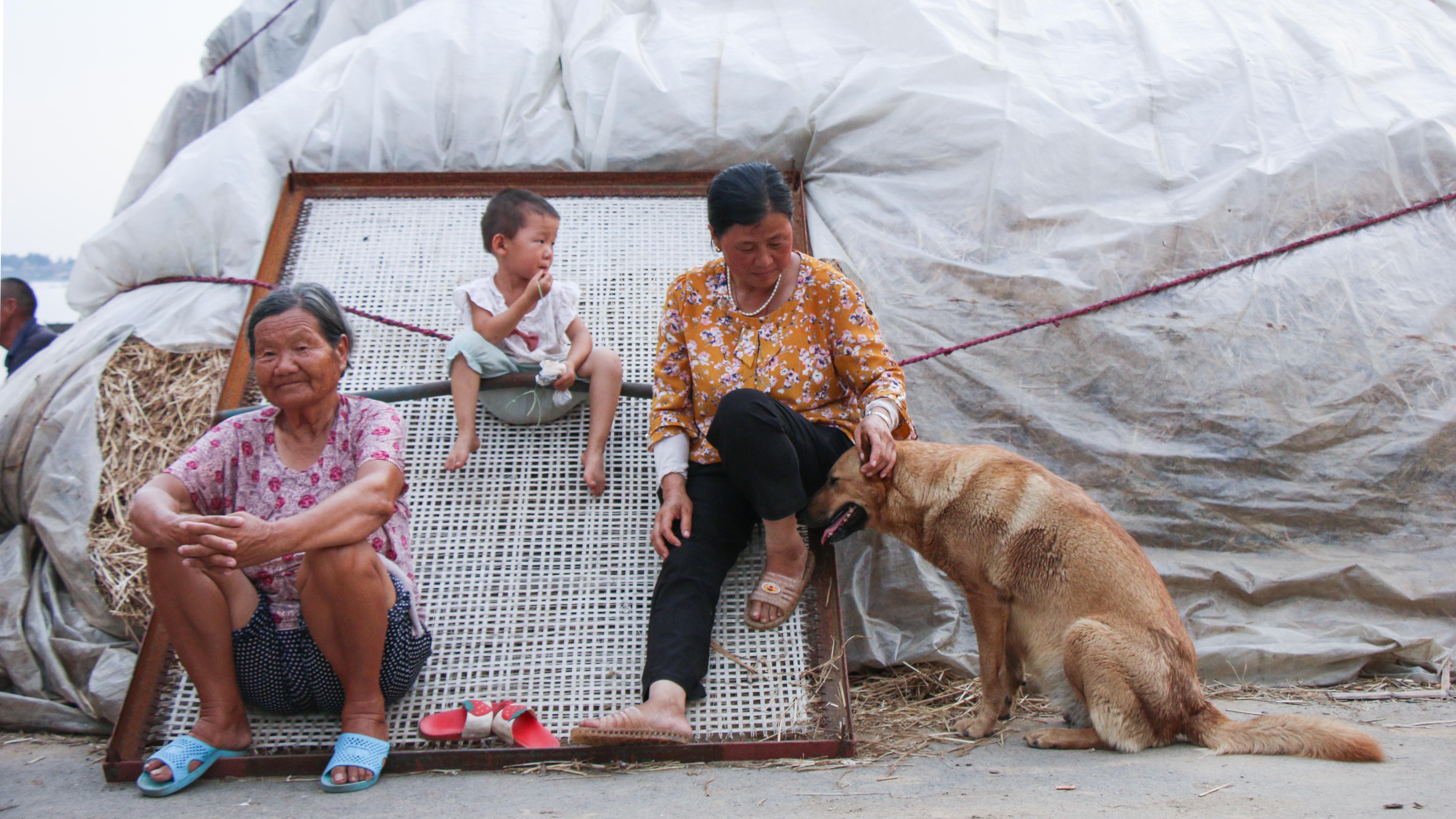
"We are not afraid of the floods because we've already got used to it," said a farmer. "As soon as the floods recede, we will replant crops with the help of the local government."

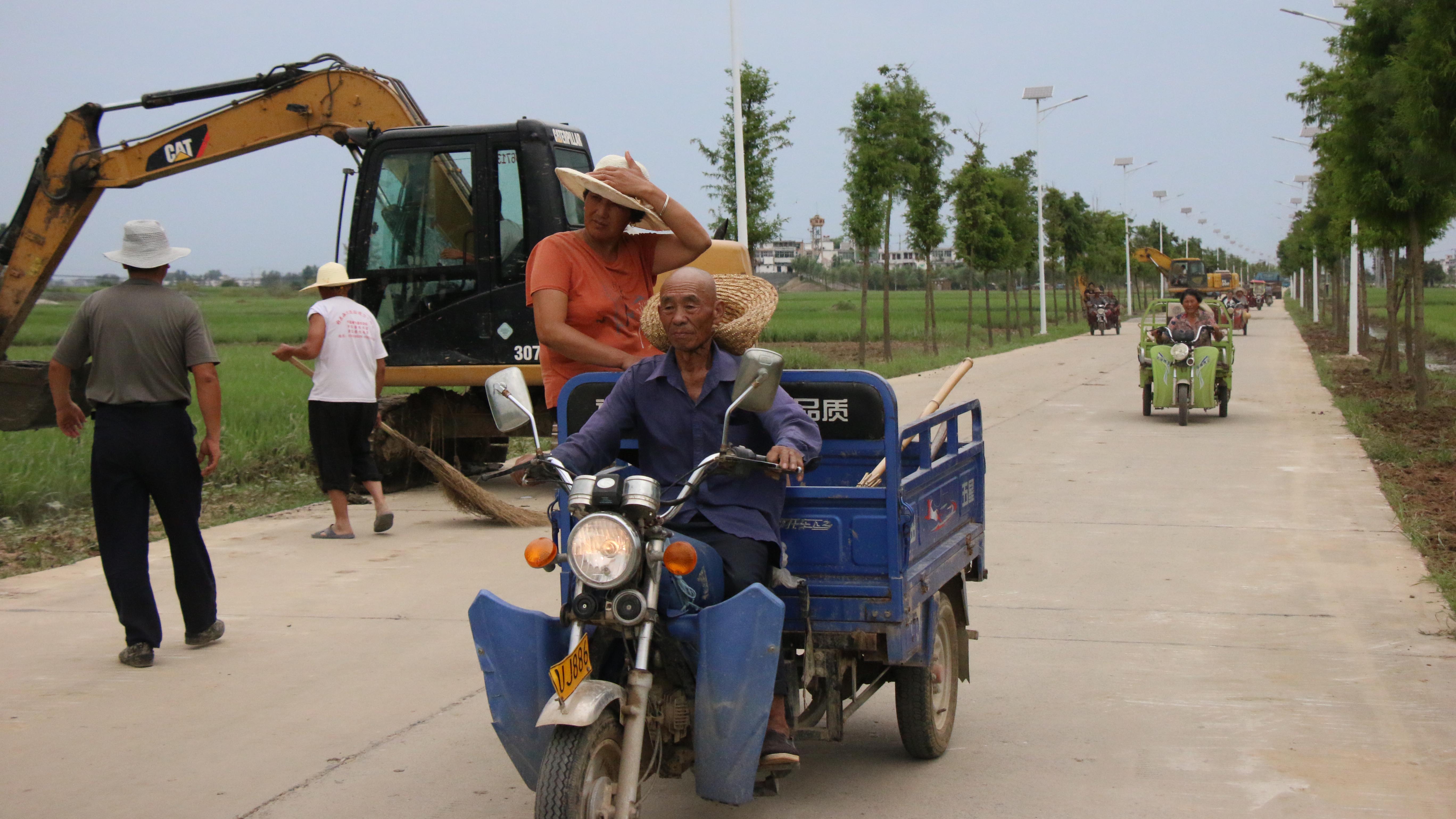
(Video filmed by CGTN Nature film crew)
(If you want to contribute and have specific expertise, please contact us at nature@cgtn.com.)

Floods engulf Central China's Wuhan. /Xinhua
Wuhan on Friday saw water level at one of the Yangtze River's crucial hydraulic stations drop below warning level after it hit record highs above danger point in the wake of continuous downpours and discharges from dams upstream since June.
But the city once hard-hit by the coronavirus earlier in the year is still exercising extreme caution, with more than 32,500 local voluntary patrollers inspecting dikes and reducing flood risks along China's longest river.
Zhou Jiahe, 22, said it's now his turn to safeguard the homeland following the older generations, noting that his grandfather fought the 1954 food and his father patrolled the dike during the 1998 flood.
Zhou is assigned to look for any seepage, piping and termite mounds at the landside, the opposite side to the riverside of the dike where other two patrollers look for the whirlpool before it causes piping, as well as possible subsidence.
The team with six members are in charge of the area stretching 400 meters long.
"We use bamboo poles to locate dangers below coverings and frighten away snakes," He said. "Rubber boots are a must during the rainy season, and they protect us from bugs and other creepy crawlies."
The clerk volunteered to patrol in early July - eight hours a day, three to four days a week. When arriving there, he said the waterside was often around 20 meters away from the top of the dike. "The increase this year has been much more severe."

But Zhou's father says residents of Wuhan who experienced the 1998 flood know the deluge this year is no worse than before - at least there's not been any water-logging.
Despite the difficulties, reinforcements over the decades have made the dike stronger and twice the size it was during the heyday of Zhou's grandfather in the 1950s.
Back then, the levee was made up of soil unlike the cement of today.
"The floods in 1954 tipped over the dike and submerged our villages," said the grandfather Zhou Songling. "The landside suffered more seepages. Some of us were bitten by snakes."
Then the government pledged to secure the city by establishing half of the country's ten water engineering projects, the 84-year-old said. "And Wuhan was saved."
"The dike was rebuilt over the generations, by my grandfather and my father as well," said Zhou Jiahe, adding he feels assured about the dike as older generations reinforced it through flood fights over the past decades.
"We guarded the dike for months, as water receded slowly," Zhou's father recalled, noting the team won't stop until the water drops below the risk level though authorities have lowered the flood alert.
Zhou says the past month may have been difficult, but for inspiration he turns not just to the older generation, he also turns to the people of Wuhan who have stepped forward to help out no matter the dangers.
(Credit: Images showing Wuhan's flood relief work at the Yangtze River and drone footage are provided by Hubei TV.)
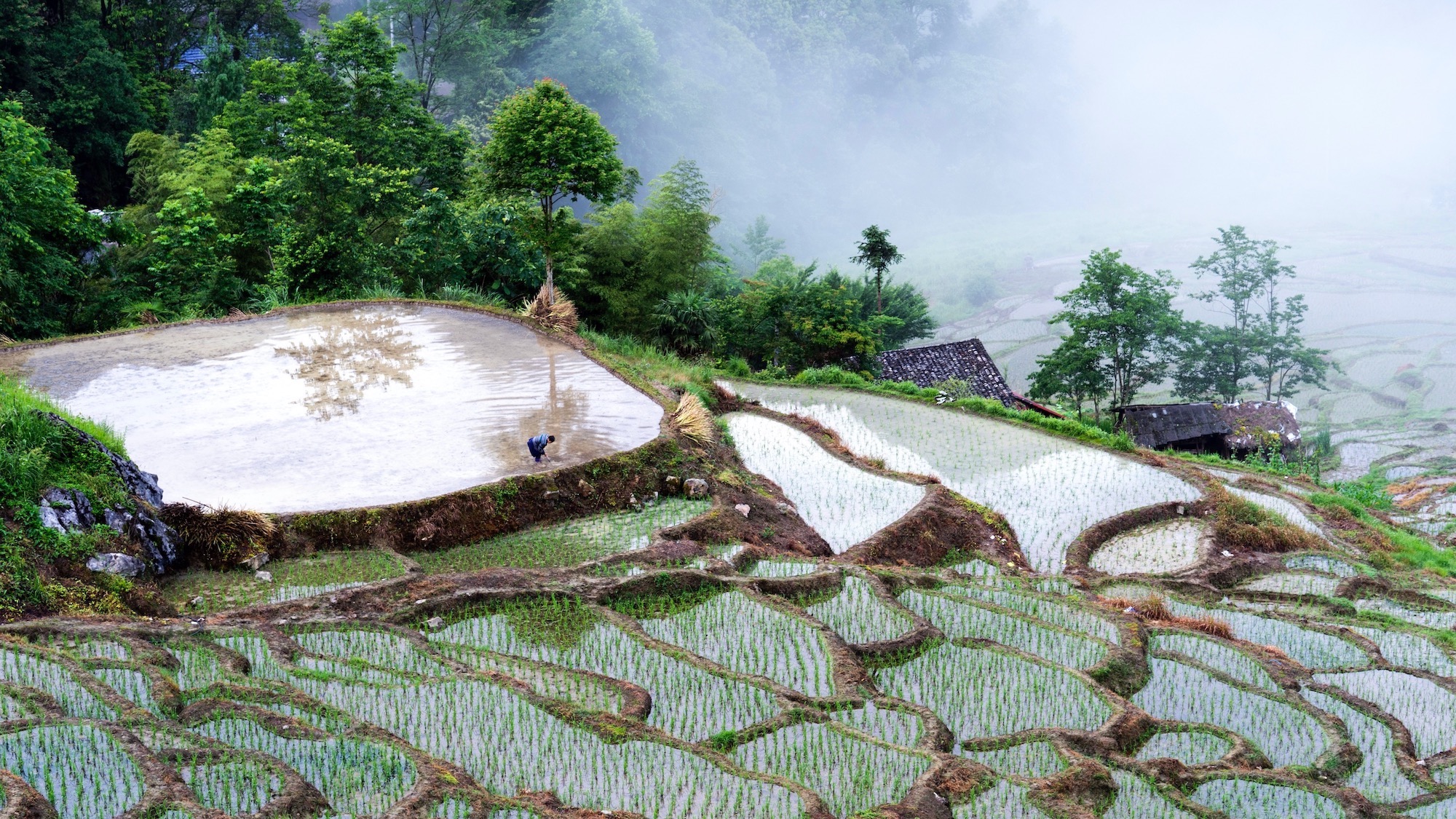
Due to continuous heavy rainfall, many farmlands in central China's Hubei Province were flooded. Farmers have been taking remedial measures with the help of local agricultural technicians to reduce economic losses.
Farmers in Huangmei County have been replanting rice seedlings since July 8. In Wuxue City, farmers have been draining the flooded farmland, replanting vegetable seeds, and repairing irrigation facilities.
(Cover image via VCG)
(If you want to contribute and have specific expertise, please contact us at nature@cgtn.com.)

Typhoon Hagupit hit Yueqing City, east China's Zhejiang Province, August 4, 2020. /CCTV
A total of 56 people have died or are missing and over 38.2 million people have been affected due to floods in China in July, the Ministry of Emergency Management said on Tuesday.
In July, the floods caused 2.996 million people to be evacuated for emergency resettlement, 27,000 houses to collapse and direct economic losses of 109.74 billion yuan.
Hagupit, the fourth typhoon of this year, landed in east China's Zhejiang Province with a maximum wind speed of 136.8 kilometers per hour in the center at around 3:30 a.m. of Tuesday, the National Meteorological Center (NMC) said, adding that it renewed alert for severe weather.

A tropical depression strengthened into Typhoon Sinlaku at 3:00 p.m. Saturday in the South China Sea, 20 kilometers west of the coastal city of Sanya, south China's Hainan Province, according to Xinhua News Agency.
"The typhoon center is sweeping the southern coast of Hainan at a speed of 25 kilometers per hour northwestward before heading to the Beibu Gulf," the report noted.
Local authorities said that Sinlaku would bring heavy downpours to southwestern and eastern parts of the island province through the weekend.
Outgoing flights from Hainan's Sanya Phoenix International Airport have been temporarily suspended due to the impact of the weather.
The Ministry of Emergency Management said on Saturday that under the influence of Sinlaku, there would have heavy rains in some areas in southern China from August 1 to August 6.
(Cover: A downpour in Sanya City, south China's Hainan Province, August 1, 2020. /CFP)
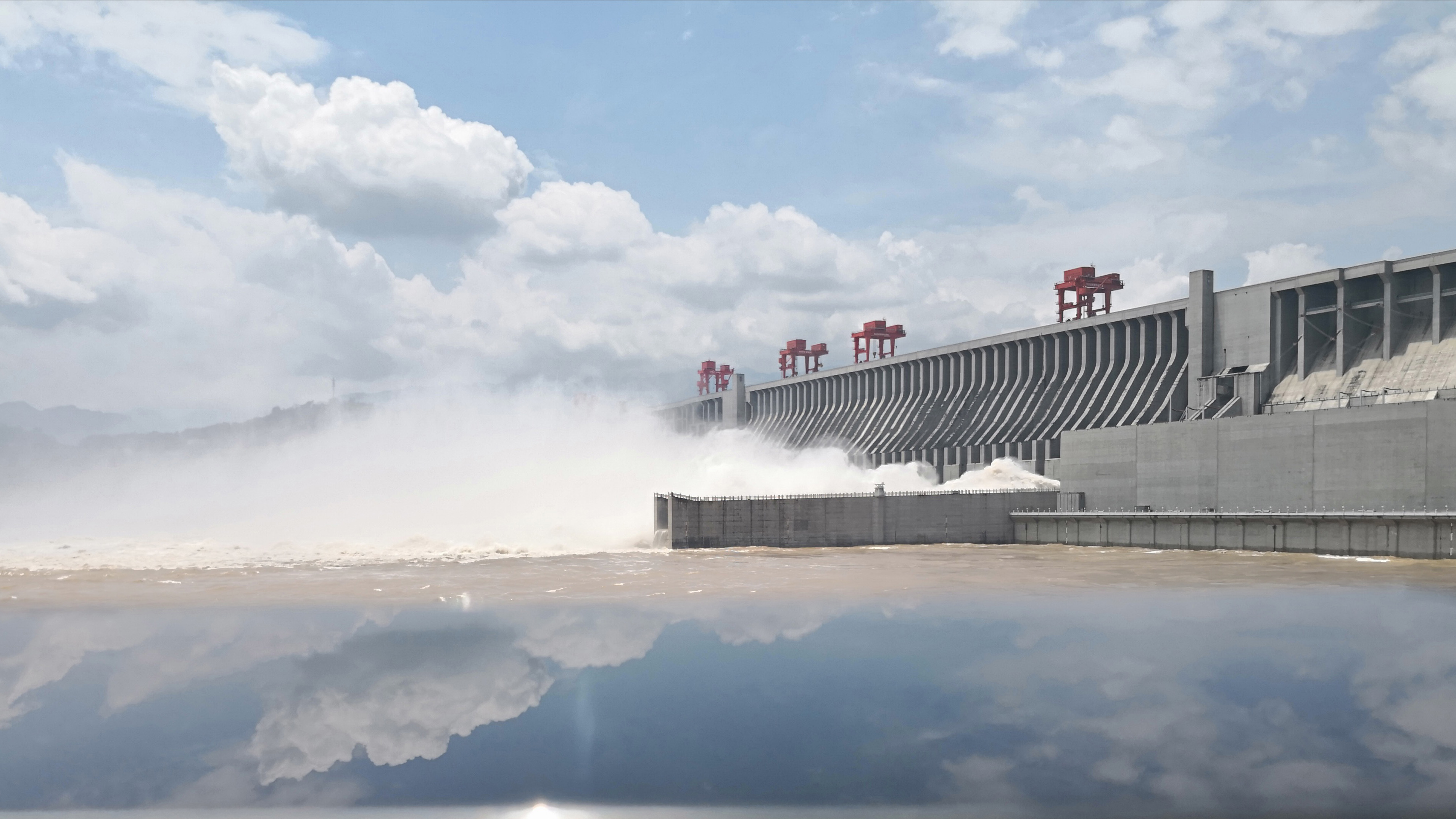
The upper reaches of China's iconic Yangtze River are experiencing its third flood of the year caused by rising water levels, leading to record levels of water gushing from the Three Gorges Dam.
The world-famous dam is reducing the floodwater by up to 37 percent.
"This can keep the water levels at major hydrologic observatory stations downstream within a safe range," said Gao Yulei, senior engineer of the Three Gorges Corporation, adding that it also can whittle down the deluge and relieve pressure on the middle and lower reaches of the river.
The flood began receding on Tuesday, and the outflow rate at the dam was increased by 2,000 cubic meters per second after water levels downstream dropped, Gao noted.
The water regulating, however, is more difficult this time round.
Continuous downpours since June have lashed large parts of southern China. The water in many rivers and lakes has hit dangerously high levels, and more heavy rainfall and rainstorms are expected in the coming days.
But experts say water levels at the Three Gorges reservoir should not pose a threat to the dam's multi-functional control system.
The 2,309-meter-long and 185-meter-high dam ran into operation in 2003. Besides, the system provides five-tier ship lock, and 34 hydropower turbo-generators.
The dam will keep releasing water to make sure there's enough capacity, Gao said, so it can prepare for further floodwaters. "We estimate the third flood will be over by the end of July."
As floods continue to ravage many parts of China, experts say many of the cities downstream are being waterlogged due to intense rainfall overwhelming drainage systems and not as a result of flooding in the river.
China renews second highest-level flood alert in Yangtze and Huaihe rivers
China on Monday decided to maintain second highest-level flood alert in the Yangtze and Huaihe rivers as heavy downpours continue to lash large parts of southern and central China.
Flood No. 3 has formed on the upper reaches of the Yangtze River. The water level on the middle and lower reaches, Dongting and Poyang lakes, has been above the danger mark for more than 20 days. Those of the Huaihe River and Taihu Lake continue to exceed the warning limit.
The Ministry of Emergency Management will continue to deploy rescue forces and relief materials in a timely manner to fully support local flood control and relief work. The authorities have allocated 30 million yuan to central China's Hubei Province to support efforts in rescue and relief.
East China's Jiangxi Province lowers flood response to second highest level
East China's Jiangxi Province on Friday afternoon downgraded its emergency response for flood control from the highest to the second-highest in the four-tier response system.
Jiangxi declared highest flood alert on July 11 as torrential rain battered much of the province, causing a vast majority of its riverside and lakeside embankments exceeding warning marks.
Poyang Lake, China's largest freshwater lake located in the eastern province of Jiangxi, has seen its water level rise to a record high at midnight on July 12.
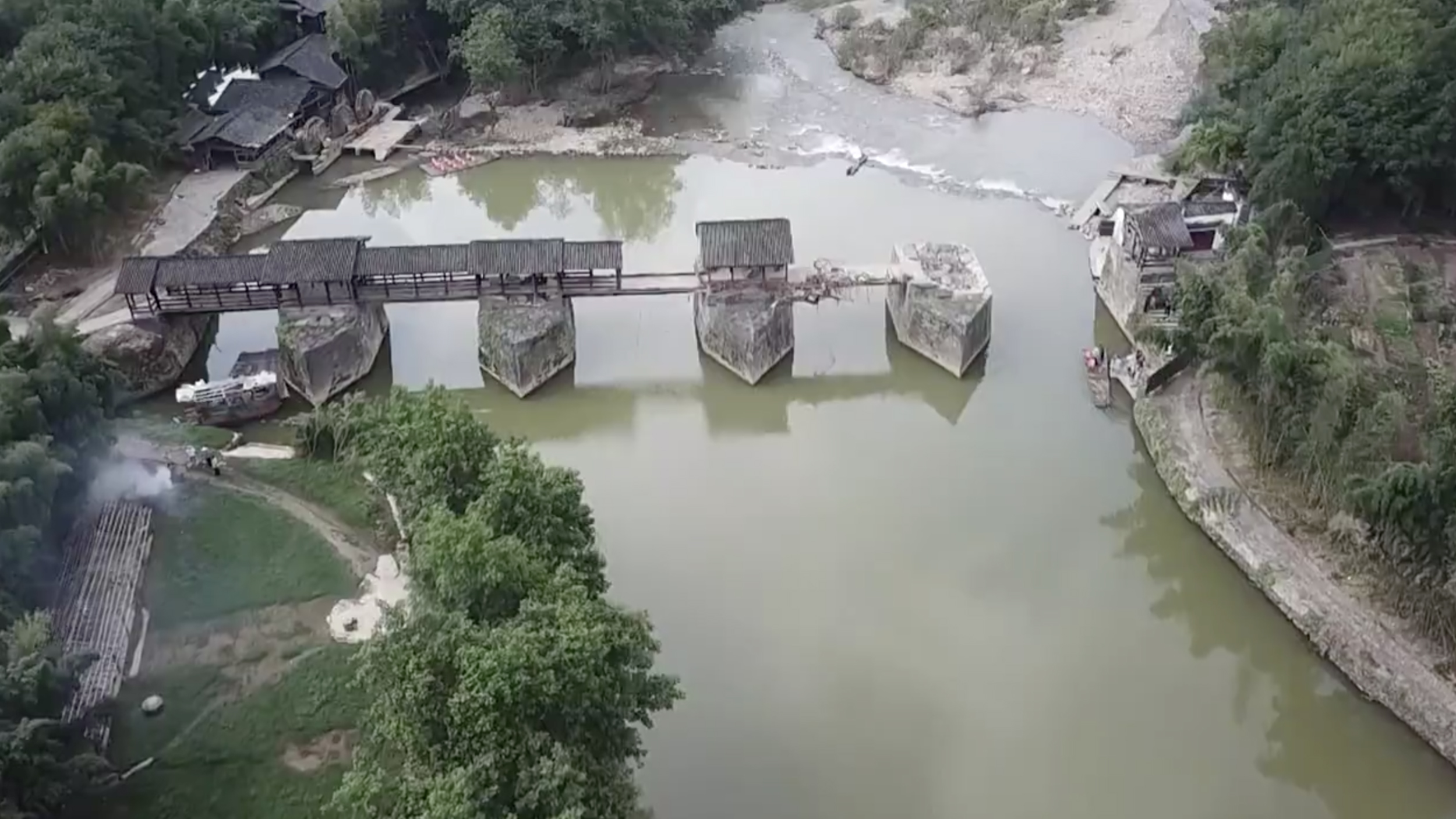
The heavy rainfall across China has damaged hundreds of important structures in the country, including an ancient bridge in the southeastern province of Jiangxi. Authorities there are asking everyone to play a part in rebuilding it.
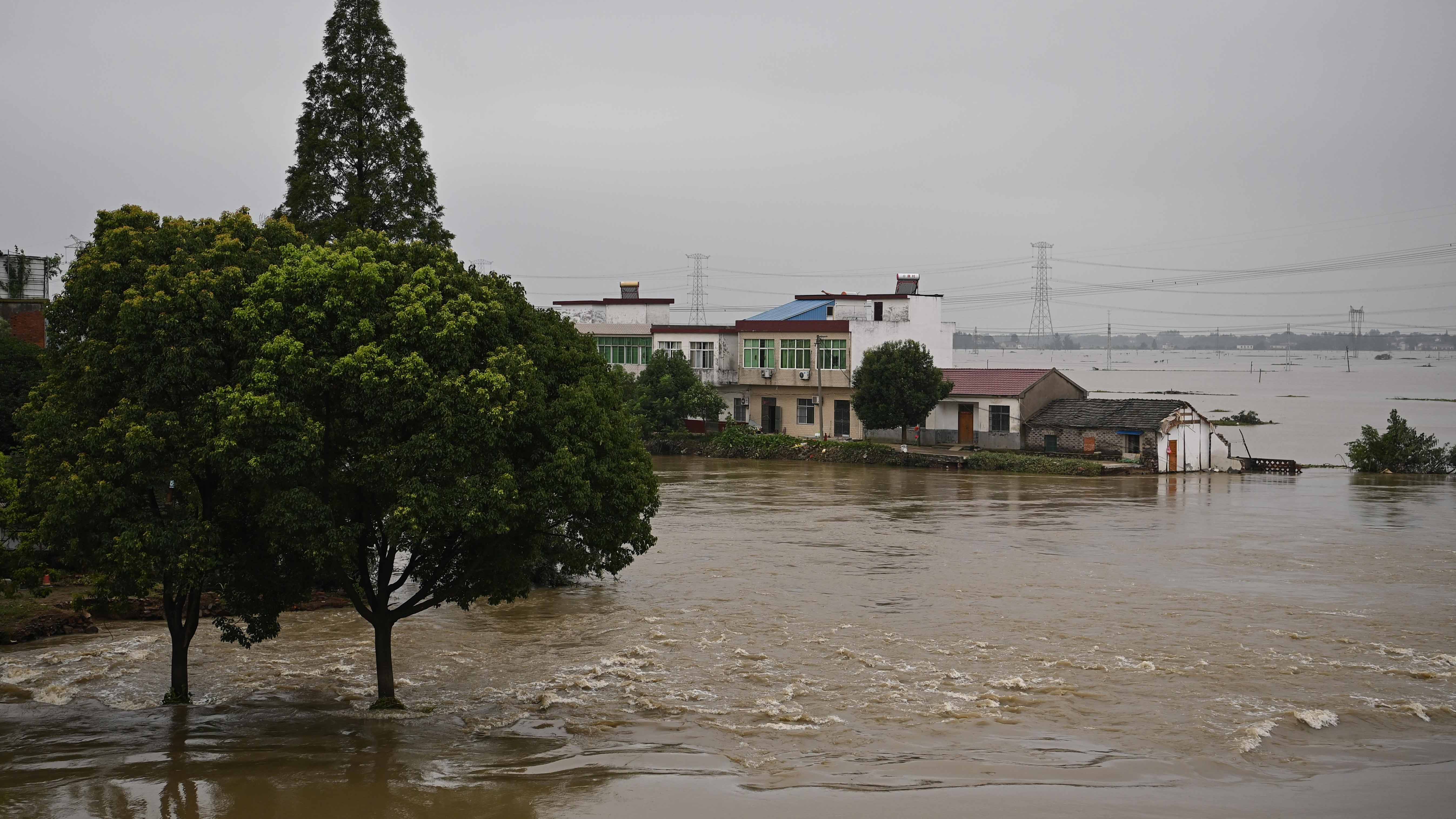
A dike has broken in Lujiang County, one of the worst-hit areas by flooding in East China's Anhui Province. A three-meter gap first appeared in the dam, and over four hours, it expanded to 50 meters. Five excavators working on trying and blocking off the breach have been washed away. A relief operation is underway, with local authorities evacuating residents from near the lake that has formed and downstream areas.
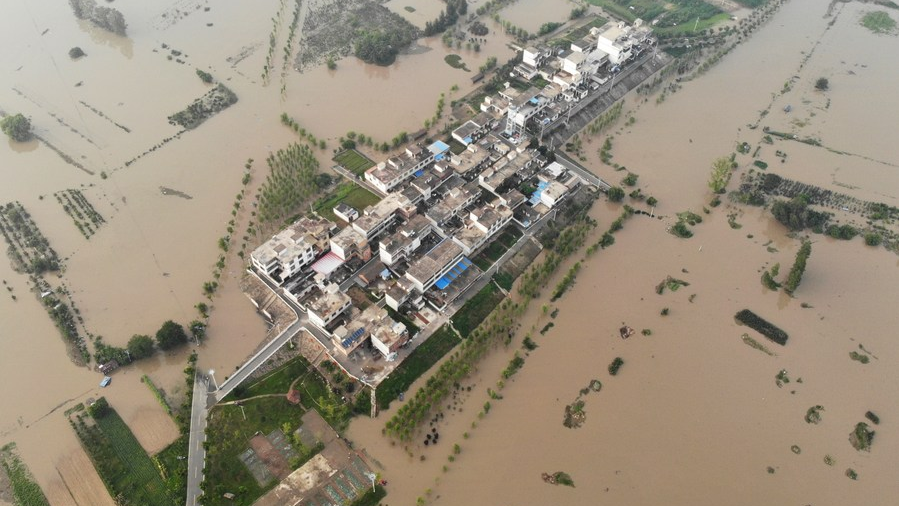
China channeled 830 million yuan (119.05 million U.S. dollars) from its central budget to restore water conservancy and agricultural production facilities in flood-hit areas, the Ministry of Finance said Wednesday.
The funds were allocated to 12 provincial regions, including Jiangxi and Hubei, for post-disaster recovery and restoration of production and living order, the ministry said.
This year's central budget has earmarked 1.29 billion yuan for the restoration of water conservancy and agricultural production facilities in flood-hit areas, official data showed.
Since June, continuous downpours have lashed large parts of southern China, and the water in many rivers in the affected regions has exceeded alert levels.
Read more: China renews yellow alert amid incessant downpours
(Cover: Aerial photo shows Zhengtaizi embankment in Mengwa flood storage area in Funan County, east China's Anhui Province, July 20, 2020. /Xinhua)
Foreign leaders send sympathy messages to Xi Jinping over floods in southern China
Leaders of countries and international organizations have recently sent messages to Chinese President Xi Jinping to express their sympathy over the heavy floods in part of southern China.
While voicing sympathy over the casualties and property damage, they have spoken highly of the tremendous efforts made by the Chinese government in fighting the floods.
In addition, they said that they believe under Xi's leadership, the Chinese people will definitely overcome the disaster and restore daily life and production in the affected areas as early as possible.
Among the leaders extending their sympathies were Russian President Vladimir Putin, Cuban President Miguel Diaz-Canel, South Korean President Moon Jae-in, Kazakh President Kassym-Jomart Tokayev, Tajik President Emomali Rahmon, Uzbek President Shavkat Mirziyoyev, Turkmen President Gurbanguly Berdymukhamedov, King Abdullah II of Jordan, and Mozambican President Filipe Nyusi, United Nations Secretary-General Antonio Guterres, and Chairman of the Boao Forum for Asia, Ban Ki-moon.
China renews yellow alert for rainstorms
China's national observatory Wednesday renewed a yellow alert for rainstorms, as incessant downpours will continue to wreak havoc across vast stretches of the country.
From Wednesday to Thursday morning, heavy rains and rainstorms are expected in parts of Shandong, Henan, Jiangsu, Anhui, Shaanxi, Chongqing, Sichuan, Yunnan and Tibet, the National Meteorological Center said.
The center warned that some areas of Shandong will experience downpours with up to 180 mm of daily rainfall.
Some of the aforementioned regions will see over 70 mm of hourly precipitation, accompanied by thunderstorms and strong winds, the center said.
The center advised local authorities to remain alert for possible flooding, landslides and mudslides, and recommended halting outdoor operations in hazardous areas.
China has a four-tier color-coded weather warning system, with red representing the most severe, followed by orange, yellow and blue.

Health authorities are conducting disinfection in Shangrao City of east China's Jiangxi Province to prevent possible outbreaks of diseases after floods have withdrawn.
Chongqing lowers emergency response for flood control, says no large-scale downpour in coming days
Southwest China's Chongqing Municipality on Tuesday afternoon said it's lowering the emergency response for flood control to Level IV from III.
China has a four-tier system for flood control response with level I being the most severe alert.
The decision comes after water level of all rivers and lakes in the municipality went below the warning level and no large scale downpour is forecast for the next two days.
Chongqing activated level III flood response on Thursday afternoon.
According to the latest data, 11 people were killed and over 556,000 people were affected across 463 villages in 31 Chongqing districts by Saturday, and the direct fiscal loss has mounted to 860 million yuan due to flood and related disasters including landslides.
Water falls to guaranteed level after floodgates opened in Anhui
Water at Huaihe River's Wangjiaba Station in east China's Anhui Province fell to the guaranteed level of 29.30 meters as of 5 p.m. on Tuesday, according to officials from China's Ministry of Water Resources.
On Monday, floodgates were opened at multiple dams in Anhui to discharge floodwater after the province continued to see heavy rainfall.
China allocates 830 million yuan flood relief funds to 12 provincial-level regions
China's Ministry of Finance (MOF) has earmarked an emergency relief fund of 830 million yuan (about 118.7 million USD) to 12 provincial-level regions, including Hunan, Hubei, and Anhui which have been hard hit by floods.
The money will be used to repair water conservancy facilities and agricultural production facilities and purchase agricultural materials for post-disaster production, the MOF said.
So far, the MOF has issued a total of 1.29 billion yuan (about 184.5 million USD) to aid local authorities with flood relief and agricultural production restoration.
Floods affect 1.35 million people in SW China's Sichuan
As of Tuesday, floods have caused 21 people dead or missing in southwest China's Sichuan Province, affecting the lives of 1.35 million people, said local officials.
More than 3,300 houses have collapsed amid the floods, causing direct financial loss worth over 4.2 billion yuan (over 60 million U.S. dollars.)
Sichuan provincial authorities said they had helped more than 110,000 people evacuate since the start of the floods, and avoided 841 casualties.
Firemen ensure small town's safety amid E China flooding
Getting around has become a daily challenge for residents in Liufang, a township in Jiujiang City of east China's Jiangxi Province. The small town near China's largest freshwater lake, the Poyang lake, has been inundated after heavy rains over the past week.
For many villagers, the surging water cut off their lifeline to food and daily necessities.
Click here for more.

Moving around inventory has become hardware store owner Wu Hongyu's new normal these days.
His store in Xiejiatan Township, Poyang County, east China's Jiangxi Province, had been submerged for three days. His was among 1,500 flooded after a reservoir on a nearby river was forced to discharge floodwater on July 7.
Flash rains make his cleaning and dry-off efforts even harder, as the 45-year-old had to bring the electronics and machineries back inside the store, and vice versa.
Since July, 31 people have died or are missing and 23.85 million others have been affected due to floods in 24 provincial regions, including east China's Anhui and Jiangxi provinces, the Ministry of Emergency Management said on Sunday.
"I assumed the water level would be similar to that of the floods in 1998," Wu said, referring to the great inundation in Chinese history. "So, we shelved all of them at a height above one meter in here."
But the water level was about 1.5 meters higher than expected and continued to rise the next day.
Damages to the town, including houses and farmland are estimated at more than 300 million yuan, or about 43 million U.S. dollars.
"The loss is a big blow to these private businesses mainly owned by villagers from the countryside in the context of first the COVID-19 and now the flood," said Zhang Shangshan, secretary of the Party Committee of the township.
For Wu, the economic loss exceeds 170,000 U.S. dollars. Damaged goods were taken away by several loads, while his six warehouses were also submerged.
"My wife cried hysterically on the day of the flood," the husband said. "She cried and couldn't speak over the phone with her mother."
The couple began clean-up efforts immediately the water receded. "Passers-by were shocked to see soaked goods outside, many of them came to help clean," Wu noted.
Without insurance, Wu says he is on his own. Only a few manufacturers agreed to refund him for his losses, most won't. The local government says it's working to approve policies to help these businesses, like offering interest-free loans.
"Some have helped me by purchasing even those soaked goods," Wu said, citing the water pumps that were piled before are now almost sold out.
"My clients respect me and treat me well," he added.
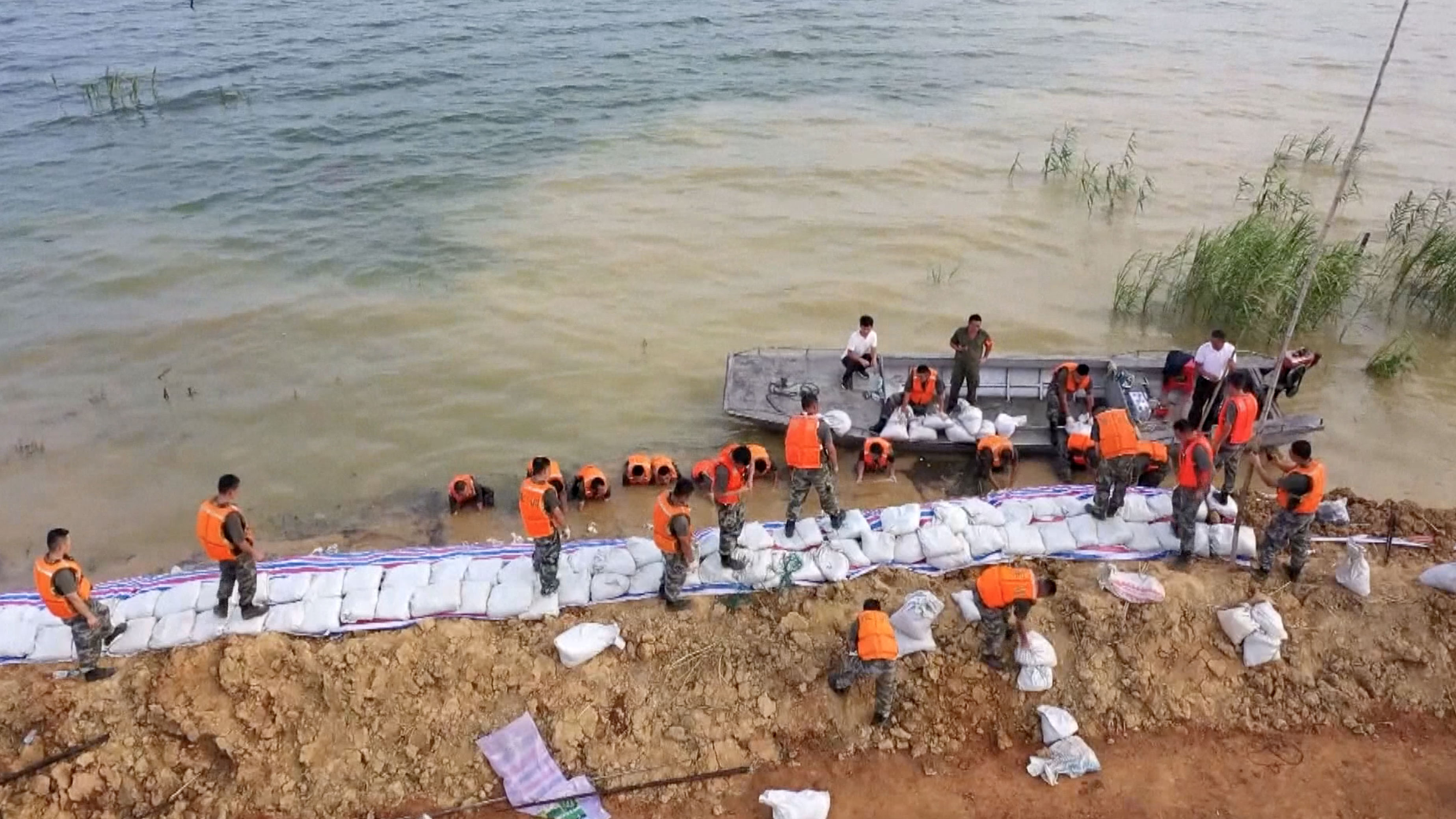
The Chinese military is using high-tech equipment to combat floods, enhancing the capacity of emergency relief and ensuring the safety of soldiers. A team of meteorologists and hydrologists has been set up to analyze real-time images sent by frontline troops to provide technical guidance. Drones are being used for infrared detection of hidden dangers resulting from seepage in river dikes, producing 3D drawings and flying to difficult terrains where soldiers cannot reach to scout.
Heavy rainfall affects 14 cities in Anhui, over 660,000 people evacuated
Heavy rain since July 2 has affected 80 counties in 14 cities in East China's Anhui Province, including Bengbu, Xuancheng, Tongling, Chizhou, Huangshan, Anqing, Wuhu, Maanshan, Fuyang and Chuzhou, according to local authorities.
As of 5:00 p.m. on Sunday, four million people have been affected by floodwaters, 664,000 people have been relocated, and about 480, 000 hectares of crops have been destroyed.
The direct economic losses caused by the downpour have so far risen to 15.27 billion yuan (2.18 billion U.S. dollars).
Floodgates opened at multiple dams in Anhui, in more severe situation
Floodgates were opened at multiple dams in east China's Anhui Province to discharge floodwater, after the province continued to see heavy rainfall, said local authorities on Monday.
The water level in several rivers and lakes in Anhui have exceeded the warning level, including the Huaihe River's Wangjiaba Station and Zhongmiao Station at Chaohu Lake.
Hefei, the provincial capital, has upgraded its emergency response for flood control from second to the highest level on Friday, said local authorities.
31 people dead or missing since July as floods batter S. China
31 people have died or are missing and 23.85 million people have been affected due to floods in 24 provincial regions, including east China's Anhui and Jiangxi provinces since July, the Ministry of Emergency Management said on Sunday.
Since July, he floods have caused 16,000 houses to collapse and led to direct economic losses worth 64.39 billion yuan (some 9.21 billion U.S. dollars).
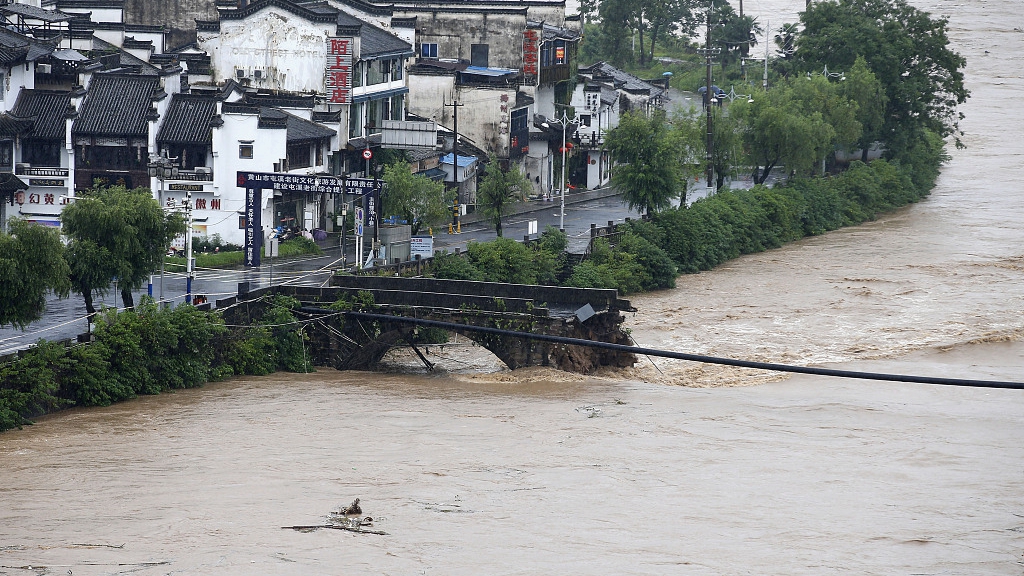
Over 500 immovable cultural relics in 11 Chinese provinces were damaged to varying degrees due to flooding as of July, making it the worst year for relics, according to the National Cultural Heritage Administration (NCHA).
Provinces along the Yangtze River have been inundated with water from massive flooding. Zhenhai Bridge in Huangshan City, Anhui Province is one of the key national cultural relics that was destroyed during the recent flood, according to Song Xinchao, deputy director of the NCHA.
He said some provinces are still under a lot of water and that securing the cultural relics in some of these areas remains "very serious."
Among the damaged cultural relics, ancient bridges, city walls and buildings were the victims.
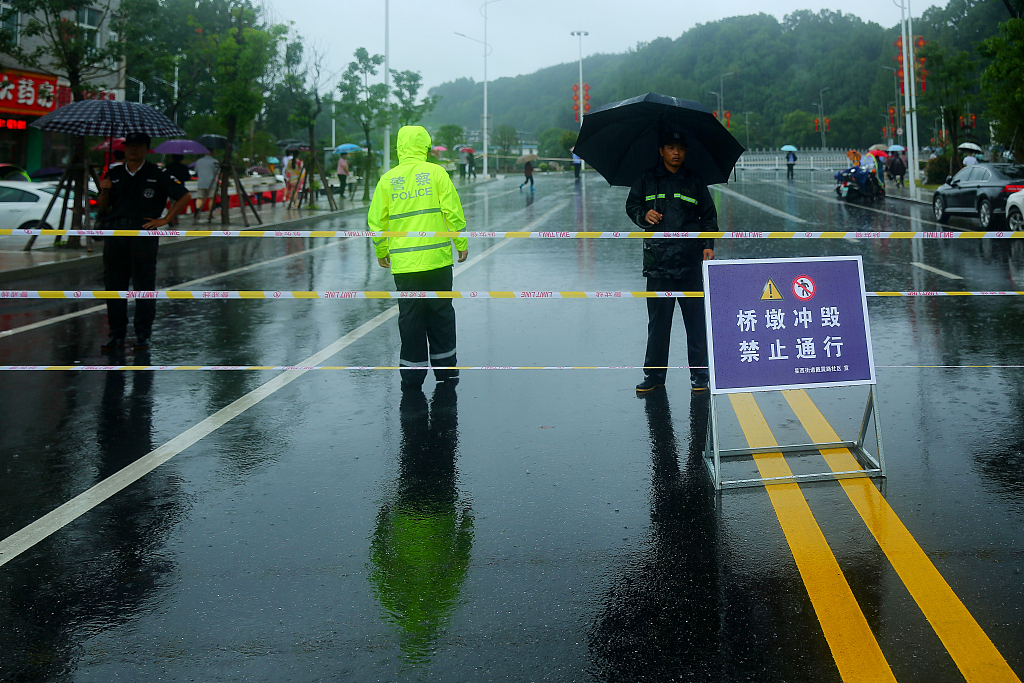
Traffic control along the bridge in Huangshan City, Anhui Province. /VCG
According to statistics from the NCHA, 76 key national cultural relics and 187 provincial cultural heritage sites have suffered damage of varying degrees.
The emergency reinforcement and protective construction around cultural relics shall be included in the cultural relic protection project, said Song.
The NCHA has allocated an emergency fund of 3.5 million yuan (500,000 U.S. dollars) to Anhui, Jiangxi, Hubei, Sichuan provinces and other hard-hit provinces.
(Cover image: Zhenhai Bridge in Tunxi Town, Huangshan City, Anhui Province that was destroyed by the flooding. /VCG)
Emergency response upgraded over China's Huaihe River floods
The Huaihe River Commission of the Ministry of Water Resources on Sunday raised the flood-control response from Level III to Level II.
The water level at the Wangjiaba hydrological station on the main course of the Huaihe River rose to 28.74 meters as of 10:06 a.m. Sunday, which exceeds the alert level of 27.5 meters, and has continued to rise.
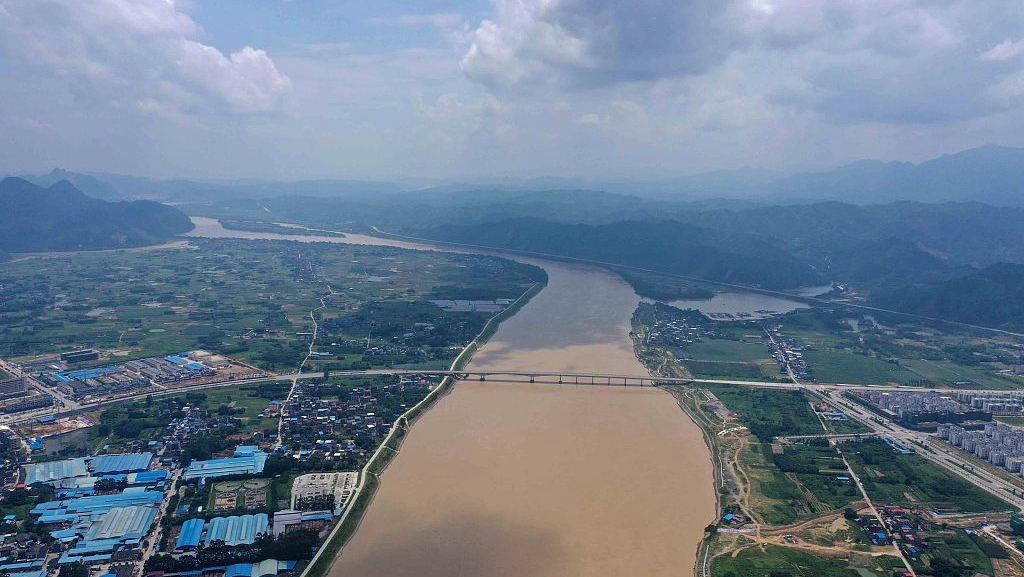
China's national observatory on Sunday renewed a yellow alert for rainstorms as incessant downpours would continue to wreak havoc in vast stretches of the country.
From Sunday morning to Monday morning, heavy rains and rainstorms are expected in parts of the Tibet Autonomous Region, Yunnan and Guizhou provinces and the Guangxi Zhuang Autonomous Region, among other regions, the National Meteorological Center said, warning that some areas of Jilin, Liaoning and Anhui provinces will experience downpours of up to 150 millimeters of daily rainfall.
Some regions will see over 70 mm of hourly precipitation, accompanied by thunderstorms and strong winds, the center said.
The center advised local authorities to remain alert for possible flooding, landslides and mudslides and recommended halting outdoor operations in hazardous areas.
The center also renewed a yellow alert for high temperatures in the country's southern areas, as well as the Xinjiang Uygur and Inner Mongolia autonomous regions and Sichuan Province, on Sunday.
(Cover: Liuzhou City, south China's Guangxi Zhuang Autonomous Region, July 13, 2020. /People's Daily)
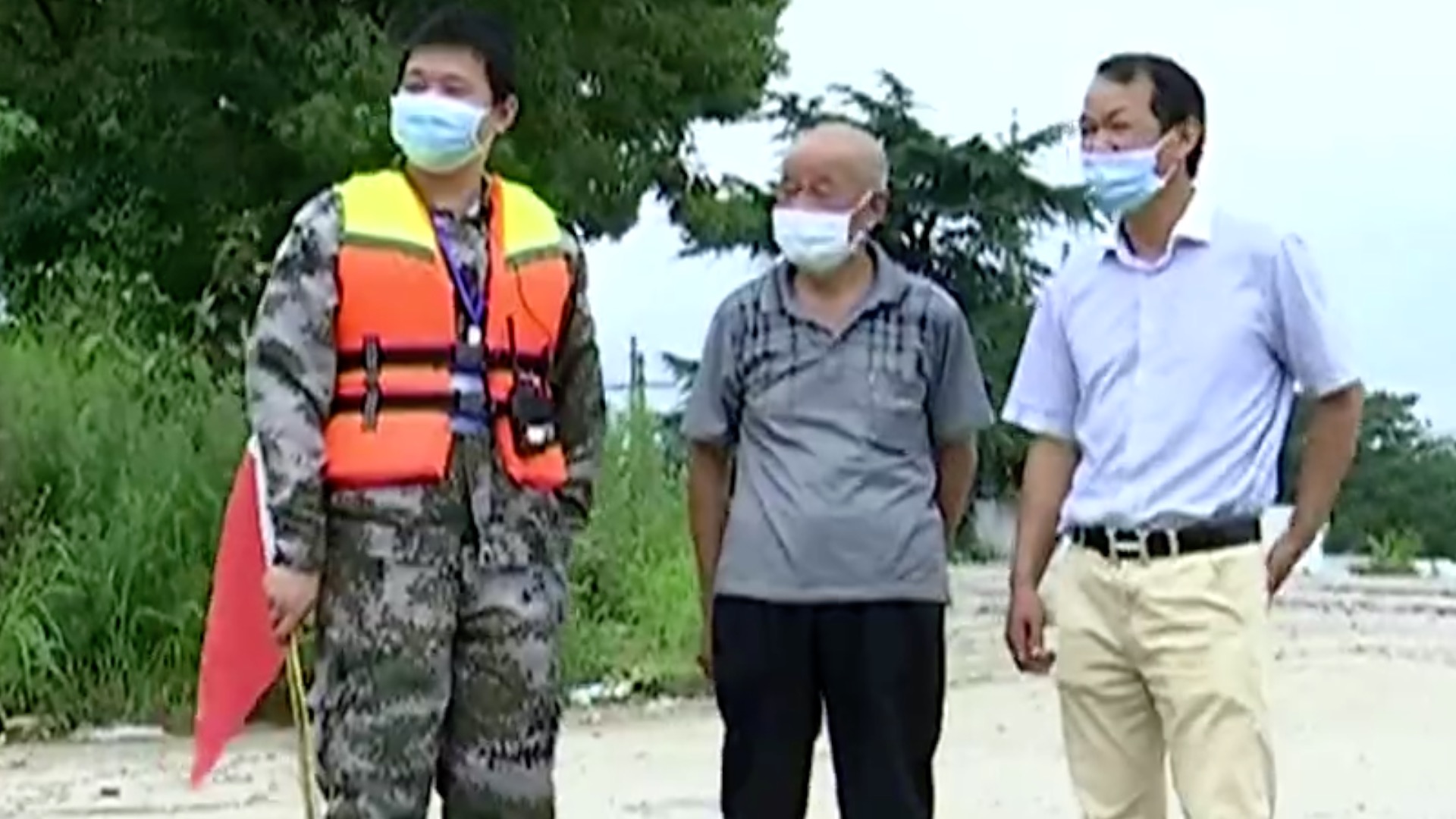
In Wuhan City, Zhou Jiahe, a 22-year-old young man, signed up recently for flood prevention and levee patrol work that's now extended to three generations of his family.
His father and grandfather volunteered in battling the 1954 and 1998 floods, respectively. Zhou said his father named him "Jiahe" with a wish that he would protect the country. So, he decided it was time for him to do the same thing his family did.
China's Anhui raises flooding response level to the highest, downpour forecasted next week
Eastern Chinese province Anhui on Saturday afternoon, upgraded its emergency response for flood control from Grade II to Grade I, the highest of the four-tier system.
According to the provincial government, water in the mainstream of Yangtze River and a key hydrological station, Wangjiaba Station, of Huaihe Lake in Anhui have all exceeded the warning level as another round of strong downpour is forecasted around next Tuesday.
By the time the water level at Wangjiaba Station might pass the guarantee level.
The 1,000-km-long Huaihe River is one of China's major waterways, running through the east of the country between the Yangtze and Yellow rivers. It saw the first flood of the year on Friday evening.
Earlier on Saturday afternoon, Anhui Province also moved up its flood and drought emergency response to the highest.
Massive floods reach China's Three Gorges reservoir
The Three Gorges reservoir in central China's Hubei Province has seen its second flood along the Yangtze River in 2020, the largest one arriving at the reservoir so far this year.
At 8 a.m. Saturday, the inbound flow of water reached 61,000 cubic meters per second while the outbound flow was 33,000 cubic meters per second, with 45 percent of floodwater withheld in the reservoir, according to the China Three Gorges Corporation.
Three lower floodgates of the Three Gorges Dam opened to discharge the floodwater on Saturday morning, with various parameters of the dam at safety levels.
After withholding rounds of floodwaters, the water level of the reservoir has reached 160.17 meters, more than 15 meters higher than the flood limit level.
It is expected that this round of floods will recede after it peaked on Saturday, but a new round of floods is forecast to arrive by Tuesday, according to the corporation's approximation.
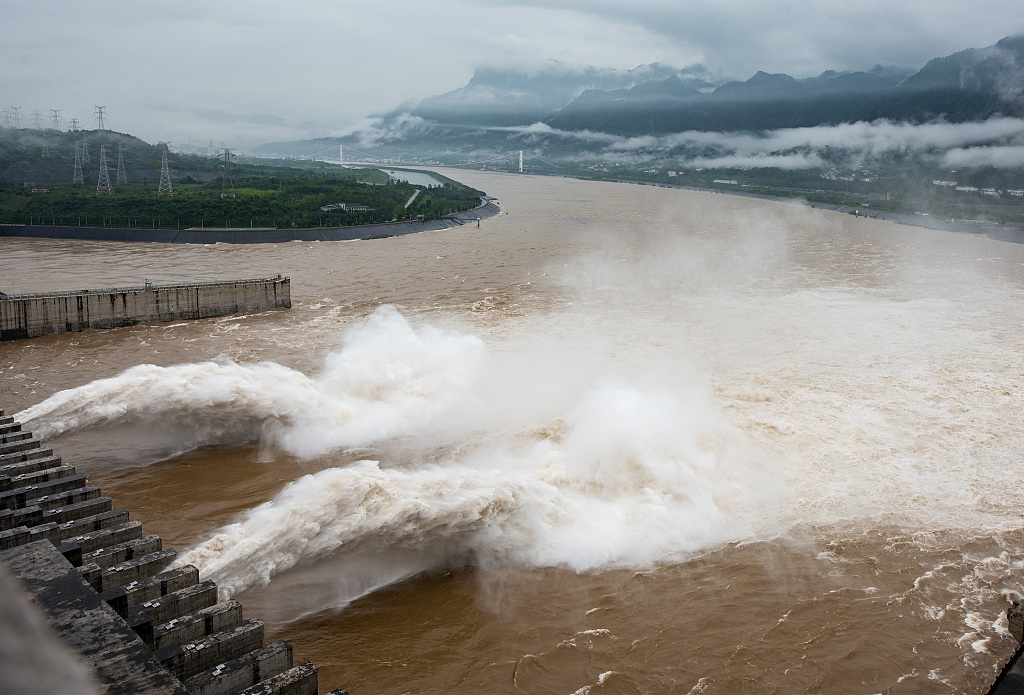
Three lower floodgates of the Three Gorges Dam discharge the floodwater in Yichang, central China's Hubei Province, July 17, 2020. /VCG
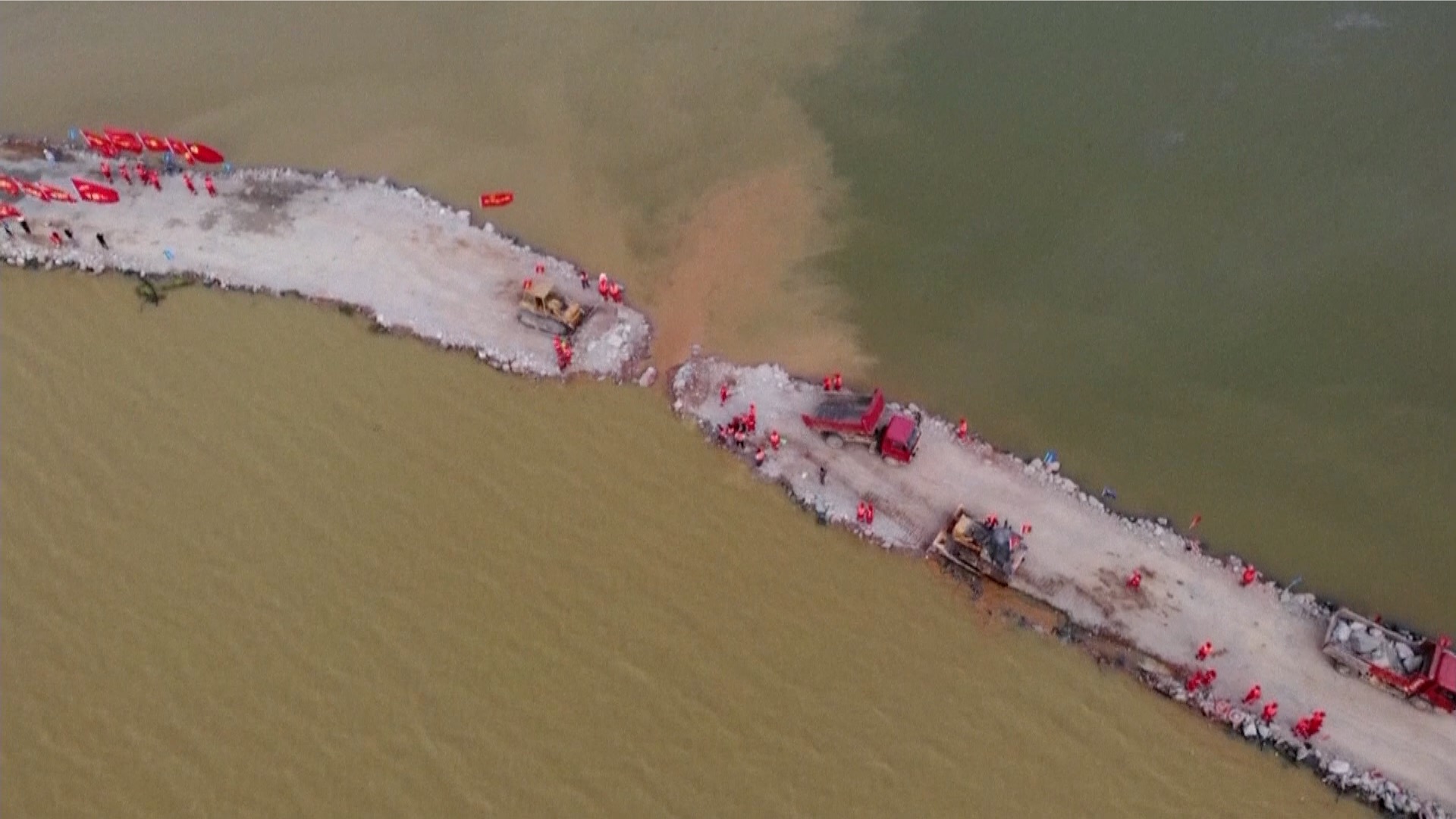
The repairs for the 188-meter-long breach of the Zhongzhou Dike near the Poyang Lake, in east China's Jiangxi Province have been completed.
The dike was breached on July 9 following continuous downpours.
Crews then began to repair the dike on Monday.
Repairs started with the broadening and solidification of the road, enabling excavators to pass through.
Following the road repair, a massive amount of earth and stones was transported to fix the breach.
In the final phase, large blocks of stones were used to mitigate the impact of the flood flow.
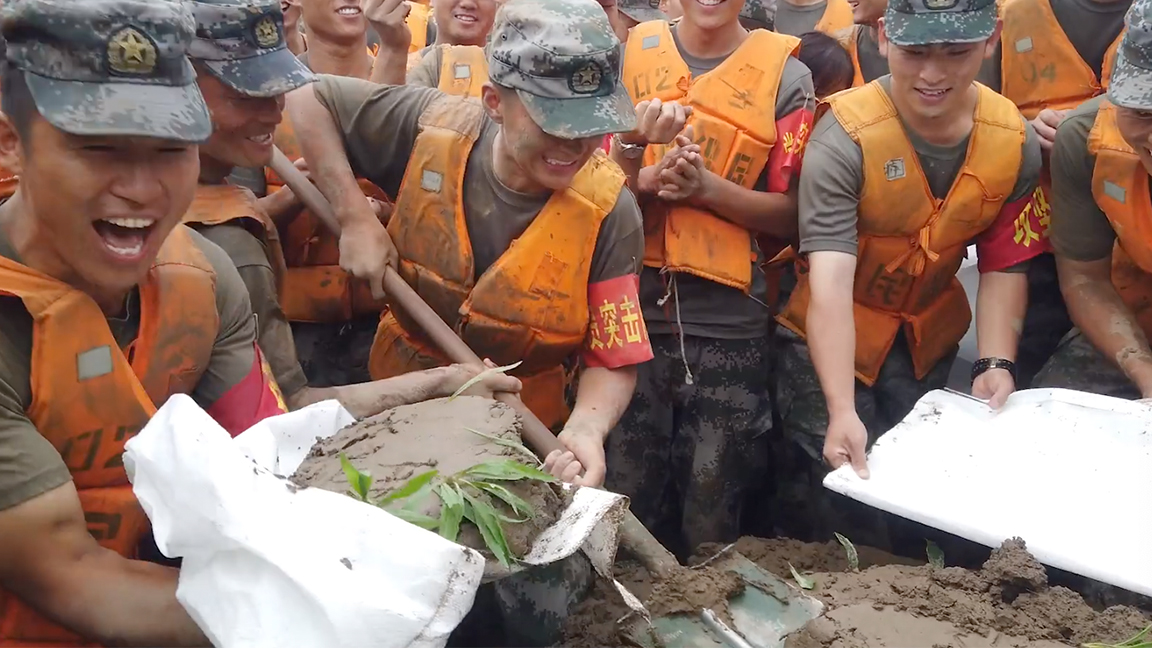
Two Chinese soldiers in Anqing City, east China's Anhui Province, had a surprising and unforgettable birthday while fighting floods on Thursday. They received a cake made with mud by their teammates.
China's Huaihe River sees first flood of the year
China's Huaihe River saw its first flood of the year on Friday evening after days of torrential rains since July 10, according to the Huaihe River Commission of the Ministry of Water Resources.
The water level at the Wangjiaba hydrological station on the main course of the Huaihe River rose to 27.74 meters as of 6:00 a.m. Saturday, which exceeds the alert level of 27.5 meters and is still continuing to rise, according to the commission located in east China's Anhui Province.
The hydrologic bureau of the commission has issued a yellow alert for floods.
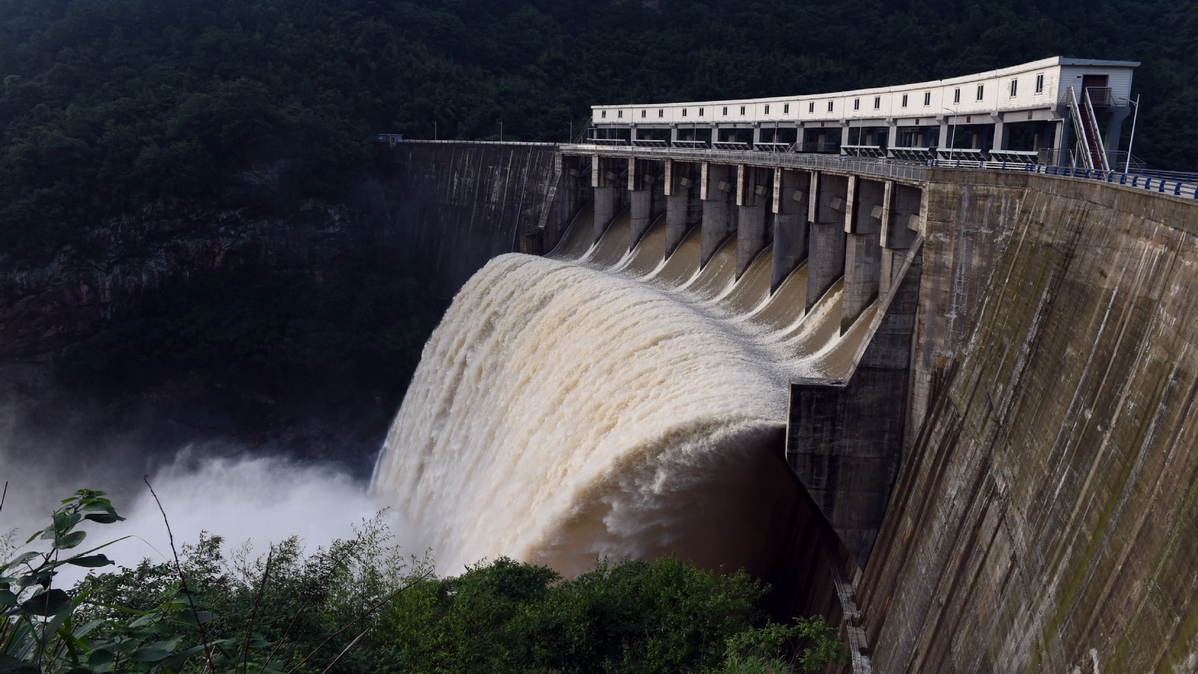
A reservoir discharges water in Jinzhai County, East China's Anhui Province, June 16, 2020. /Xinhua
China issues red alert for flood in Yangtze River's Nanjing section
China has issued a red alert for flood, highest of the four-tier system, in Nanjing section of Yangtze River in east China's Jiangsu Province staring from 9:00 a.m. local time on Saturday, said the provincial water resources bureau.
According to the bureau, the water level of Yangtze River's Nanjing section reached 10.26 meters at 7:50 a.m. Saturday, exceeding its warning level by 1.56 meters.
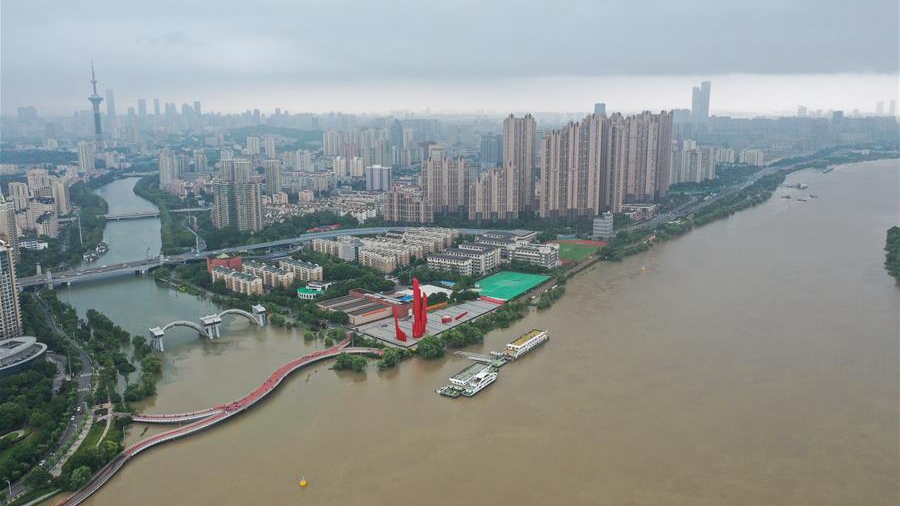
Aerial photo shows the Yangtze River in Nanjing, east China's Jiangsu Province, July 13, 2020. /Xinhua
Xi Jinping urges officials and Party members to take responsibility in flood-triggered relief work
Chinese President Xi Jinping on Friday urged local governments and Party members to take responsibility in flood-triggered disaster prevention and relief work as large parts of China were reeling from the worst floods in decades.
Xi, also general secretary of the Communist Party of China (CPC) Central Committee, made the remarks during a meeting of the Standing Committee of the Political Bureau of the CPC Central Committee.
It is the third instruction from Xi on natural disaster control and prevention in less than three weeks.
Click here for more
Multiple regions in China level flood emergency response level
China allocated relief materials, blankets and tents, to Anhui and Hunan provinces which have been hit hard by flooding. Multiple regions in China have upgraded their flood emergency response level as the second flood peak this year has formed on the upper reaches of the Yangtze River on Friday, according to local authorities.
The peak flow is expected to reach 55,000 cubic meters per second at 8:00 p.m. Beijing Time on Friday, which will be stronger than the first one earlier this month, the authorities said.
Wuhu City in east China's Anhui Province has upgraded its emergency flood control response from second to highest.
The local authorities in Enshi City, central China's Hubei Province, has upgraded its emergency flood control response from third to second, and a total of 28,793 people were evacuated.
Taihu Lake in East China's Jiangsu Province has activated the highest level of flood emergency response, and also launched defense highest level of flood and drought emergency response at same time, local authorities said on Friday.
Wuhan's three districts active highest level of flood emergency response
Wuhan's Jiangan district, Dongxihu District and Huangpi District upgraded their emergency response for flood control to the highest on Friday, according to local authorities.
At present, the Hanjiang River and Fuhe River reaches in Dongxihu District have exceeded the warning level and lasted for a long time. Affected by heavy rainfall upstream, the water level at Tongjiahu Station in the city is expected to reach the guaranteed level at 20:00 on Friday.
Heavy rain causes rising water levels in Yangtze River
The second flood peak this year is forming in the upper reaches of China's Yangtze River as water levels rise due to intense downpours, according to local authorities.
The peak flow is expected to reach 55,000 cubic meters per second at 8:00 p.m. Beijing Time on Friday, the authorities said.
(Cover: VCG)
Water levels go down in middle and lower reaches of Yangtze River
Water levels have fallen in the middle and lower reaches of Yangtze River, as well as China's two major freshwater lakes – Poyang Lake in eastern Jiangxi Province and Dongting Lake in central Hunan Province, the Ministry of Water Resources said on Thursday.
However, the water level in Taihu Lake in eastern Jiangsu Province has shown a slight increase and is expected to exceed the guarantee level in three days.
The guarantee water level refers to the upper limit that ensures the safety of embankments and affiliated projects.
On Thursday morning, the water level at Taihu Lake reached 4.59 meters, 0.79 meters higher than the warning level.
The ministry also predicted that levels may bounce back in Yangtze's middle reach and Dongting Lake in the next three days as China battles flooding in its eastern and central regions.
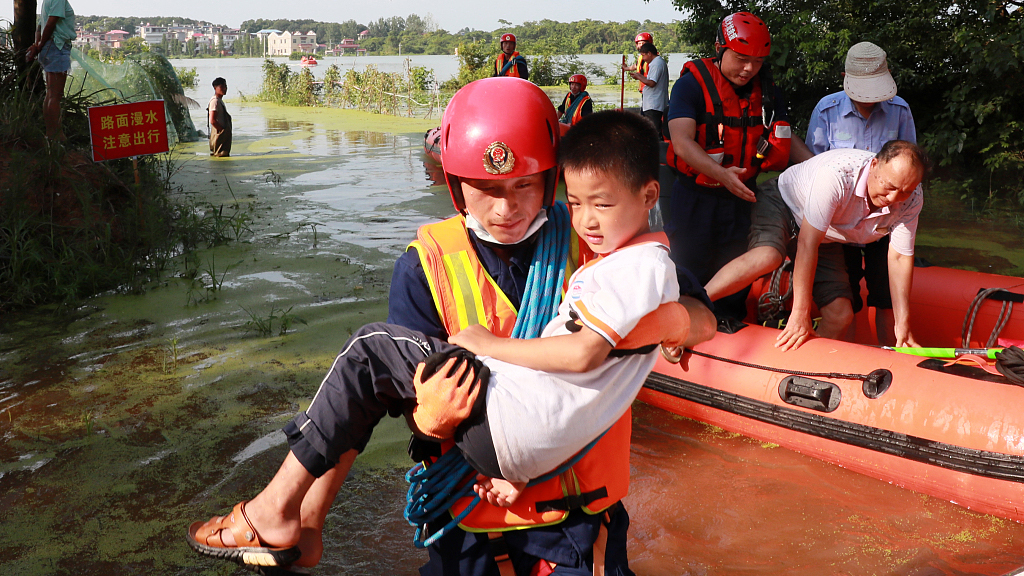
China's Jiangxi Province is on high alert due to flooding. The province has been one of the hardest-hit areas.
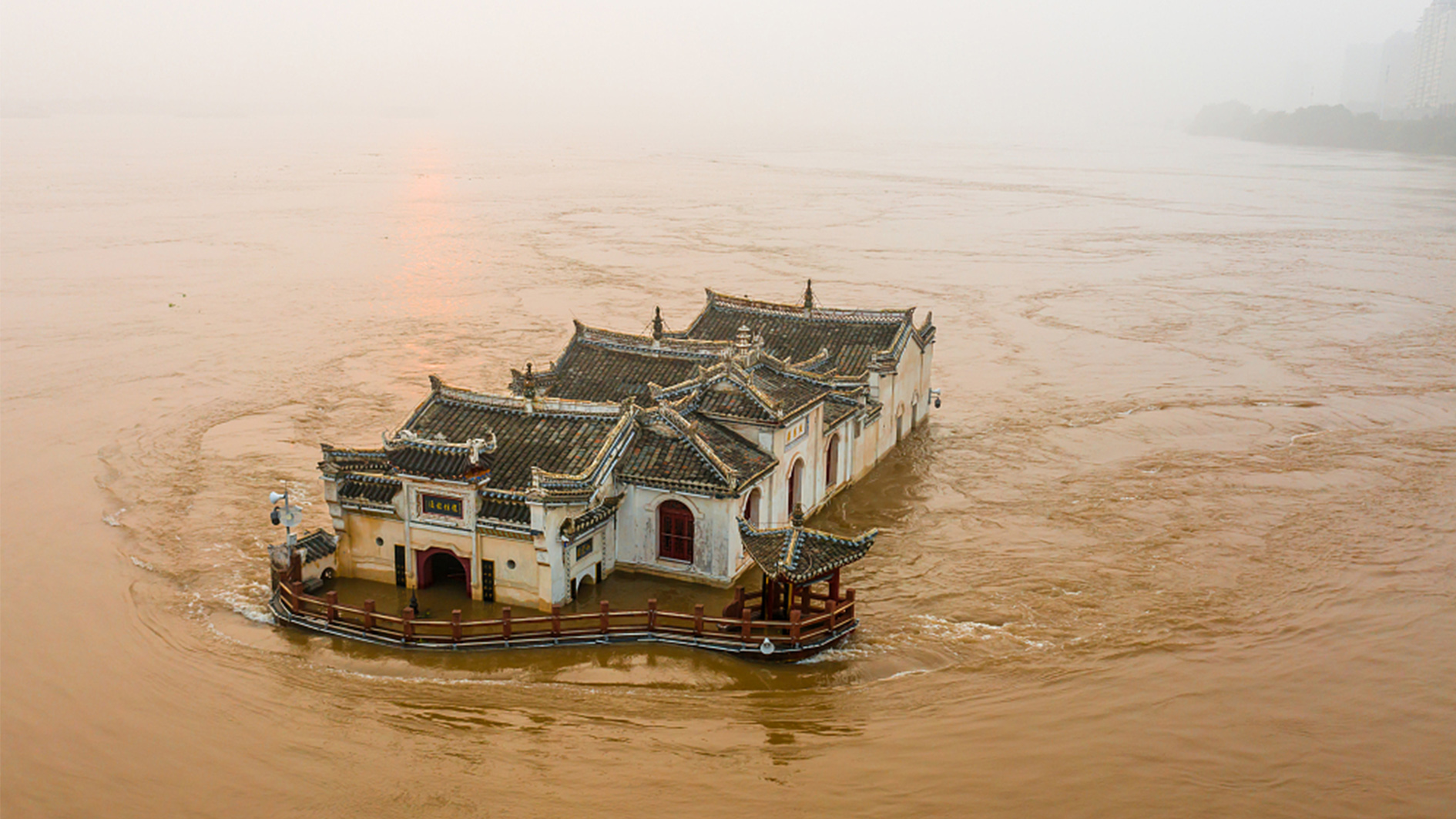
An over 700-year-old pavilion has captured the imagination of Chinese citizens for withstanding the powerful floodwaters on the Yangtze River during the recent heavy rainfall. Over 300 rivers across 19 provincial-level regions have surpassed danger levels this year, and a dozen have seen their most severe floods in recent history, prompting concern for some historical sites located near major waterways. Described as "the first pavilion on Yangtze River," the ancient Guanyin Pavilion dates back to the Song Dynasty in the 13th century. Many were surprised to see it standing in the middle of the overflowing river after the recent flood.
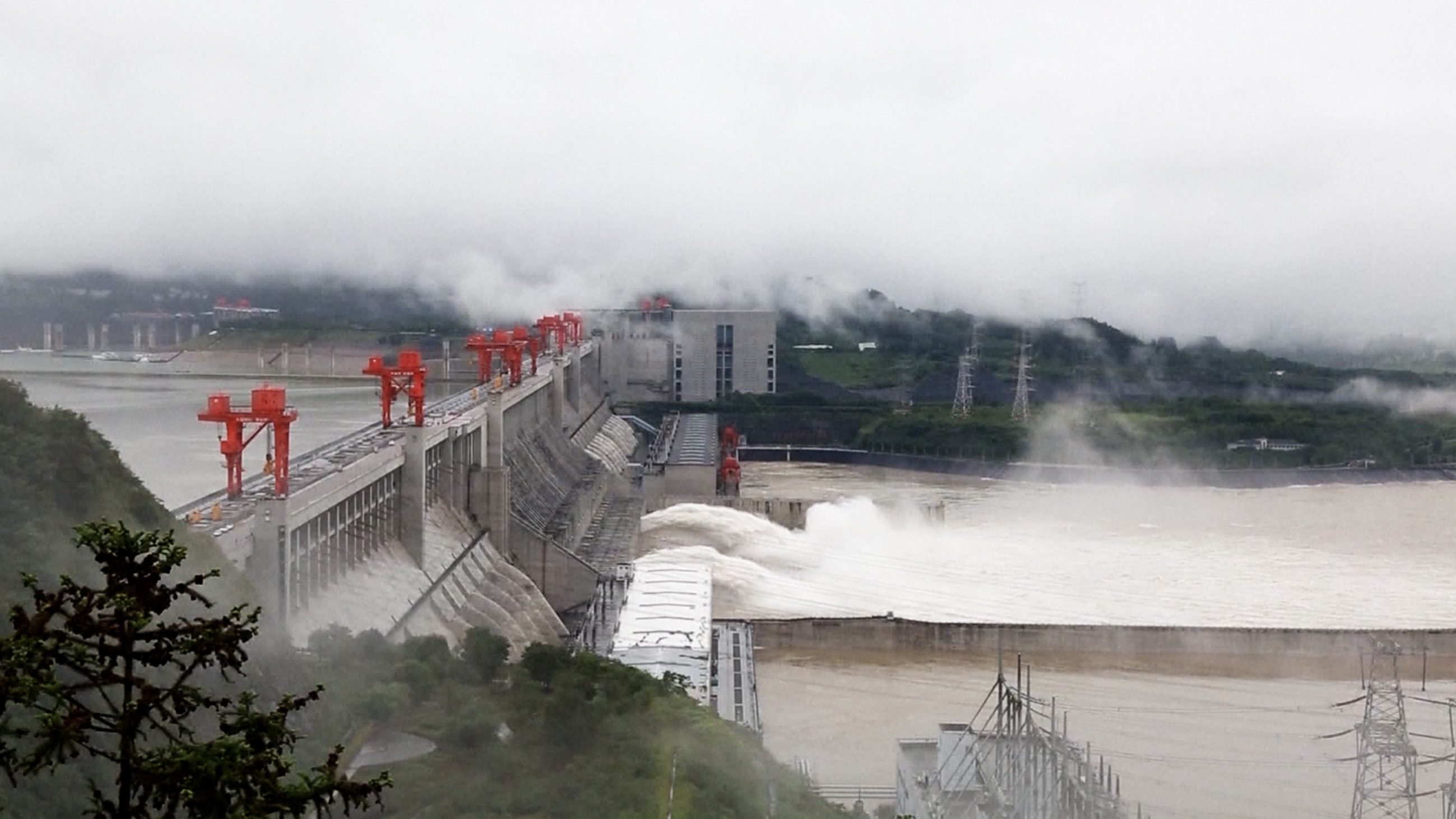
This year's rainstorms in southern China are characterized by a wide range of impacts, a long duration, high intensity and incessant heavy rainfall in some regions, China Meteorological Administration said on Wednesday.
However, judging from the rainstorm duration, intensity and impact range, the disaster in the Yangtze River Basin this year is weaker than the one in 1998.
Still, the causes of disaster are similar: the subtropical high-pressure moved northward before falling southward and finally stabilizing, but the impact duration has not been as long as that in 1998. In addition, the impact area is also not as large as the one in 1998, as the rainstorm disaster that year was formed by incessant heavy rains in the entire basin.
Global warming is a major reason for the rainfall anomaly this year, according to the preliminary analysis by experts at the National Climate Center (NCC), said Song Lianchun, director of NCC.
"Observations show that global warming leads to the frequent occurrence of extreme weather and climate events, and China is in the sensitive region of climate change," said Song. "In the past 60 years, the frequency of heavy rain has increased significantly, with the number of days of heavy rain increasing by 3.9 percent per decade. The heavy rain in the Yangtze River Basin this time occurred under such a background."
"Also, the subtropical anticyclone is relatively strong this year, coupled with frequent cold air activities. The intersection of warm and cold air leads to continuous heavy precipitation in the Yangtze River Basin."
Song called for high attention to the frequency and intensity of extreme weather and climate.
Global warming will change the global circulation pattern, and affect local climate through ocean-atmosphere, land-atmosphere interactions, said Song.
"We cannot say that a single extreme weather event is directly caused by climate change, but in the long run, the warming climate has led to an increase in the frequency and intensity of extreme events," Song cautioned.
China should raise awareness of climate risks and improve its ability to cope with extreme weather and climate, in particular, enhancing the level of monitoring, forecasting and early warning, he added.
So far, China has seven Fengyun meteorological satellites to monitor the country's weather condition around the clock, said Yang Jun, director of National Satellite Meteorological Center.
The satellites conduct inspections on major river basins and lakes four times a day, and closely monitor the Taihu Lake and Dongting Lake at the same time.
"For example, in case of flood and waterlogging disasters in the Miyun and Guanting reservoirs, we will timely release relevant monitoring results to the government and the public and provide services," said Yang.
(Cover photo via VCG)
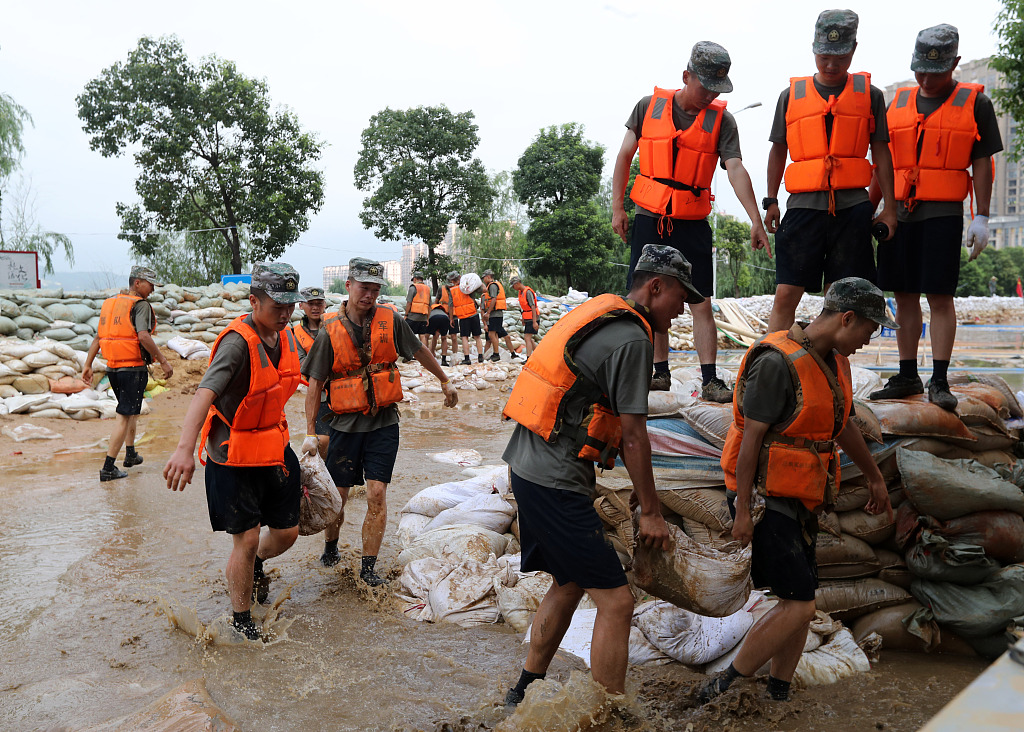
Floods affect over 6.4 million people in E China's Jiangxi
As of 9:00 p.m. Tuesday, floods have disrupted the lives of over 6.4 million people in east China's Jiangxi Province, with at least 654,000 evacuated
from flood-prone areas, officials said at a press conference on Wednesday.
Flooding and landslides caused by incessant rains have damaged at least 1,494 houses.
So far, over 259,000 people have received government aid, officials added.
East China's Anhui upgrades disaster relief emergency response
East China's Anhui Province raised its emergency response for natural disaster relief from Level III to Level II starting from late Tuesday, and the local authorities ordered five cities to orderly evacuate residents from areas near the Yangtze River.
According to local authorities, the flood crest is expected to arrive in Auhui's major control stations in one to two days.
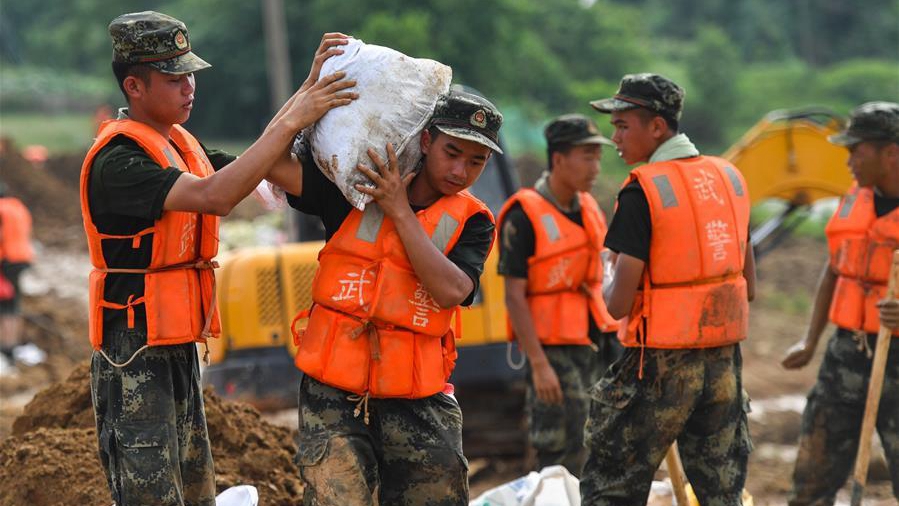
China's agricultural authorities launch level-II emergency response for natural disaster
China's Ministry of Agriculture and Rural Affairs on Tuesday launched a level-II emergency response to battle the major natural disaster in the country.
The ministry said it has dispatched expert teams to five provinces, including Jiangsu, Anhui, Jiangxi, Hubei and Hunan, for flood control and disaster relief.
(Cover: Armed policemen in Poyang County, east China's Jiangxi Province, July 13, 2020. /Xinhua)
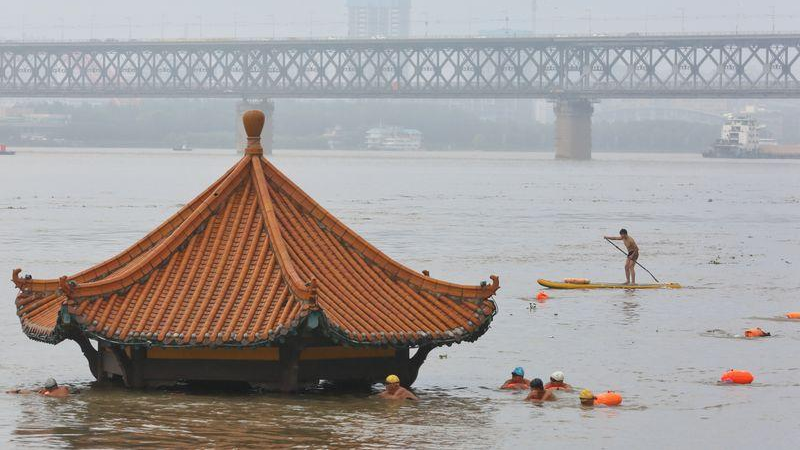
People swim near a pavilion partially submerged in floodwaters on the banks of the Yangtze River, in Wuhan, Hubei Province, July 8, 2020. /Reuters
What has changed two decades after the 1998 flood?
China is reeling from the worst flood since 1998 when the country fought a herculean battle against the brutal forces of nature. Twenty-two years later, scenes of submerged towns and Chinese soldiers carrying sandbags through muddy floodwater are evoking memories of the 1998 disaster.
So far, the floods have killed 141 people and destroyed 29,000 homes, affecting more than 38 million residents in 27 provinces, Chinese officials said on Monday. Meanwhile, flash floods and geological disasters in the southwestern mountainous regions have forced more than two million to relocate.
Click here for more.
Since June, China has been dealing with incessant rains in its southern regions. These unusually heavy downpours have led to flooding and landslides, killing over 140 people as of Tuesday morning. The situation has affected over two million residents, forcing them to evacuate their flooded and damaged houses.
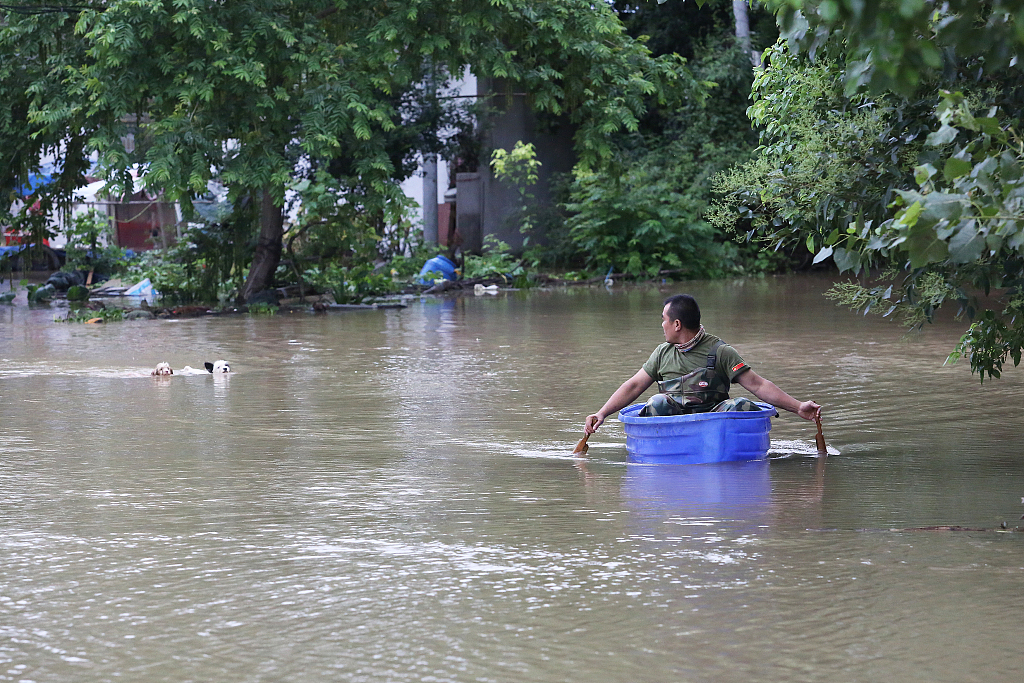
A villager paddling on a small boat and guiding two dogs to safe places in east China's Anhui Province. /VCG Photo
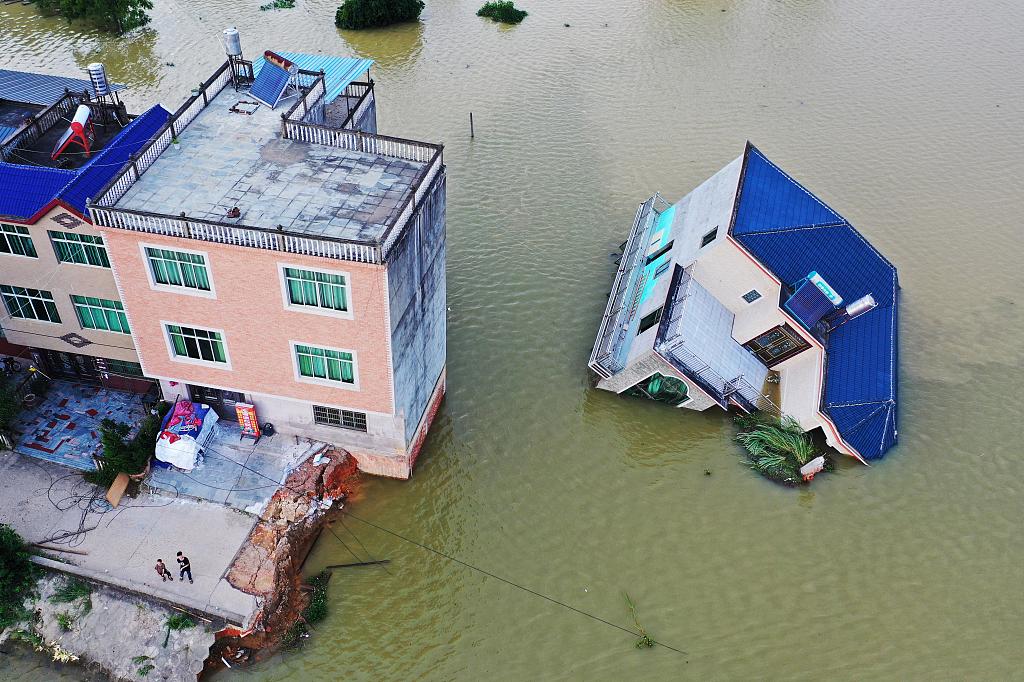
A three-story building collapsed after flooding in east China's Jiangxi Province. /VCG Photo
The intense rainfall has been on and off for weeks along the country's longest river – the Yangtze, swelling rivers and lakes and causing banks to burst. The Ministry of Water Resources said on Monday the water levels of 433 rivers in China have crossed the danger mark since early June, with 33 of them rising to historical highs.
Since June 2, the country has been on a high alert for rainstorms, the longest such alert in 13 years. At least 15 heavy and wide-range downpours have been recorded along the Yangtze River, including record-breaking single-day rainfall in Hubei and Hunan provinces, both located along the middle section of the Yangtze River.
Wang Yongguang, chief forecaster at the National Climate Center (NCC), attributed the intense rainfall this year to the Eastern Asia rainy season, or plum rain as it is more often called in China, which started a week earlier than previous years with higher-than-usual intensity.
Ma Xuekuan, chief forecaster at the National Meteorological Center, pointed to atmospheric circulation, saying that the West Pacific subtropical high, which increases its intensity every summer, brought more moisture from the northern Indian Ocean this year because of higher temperatures in the region.
Last month, reports showed that temperatures in the Arctic Circle had hit an all-time record. However, the two experts did not link the severe flooding to global warming.
Huang Lei from the Climate Change Adaptation Division of NCC, claimed there has been no evidence showing direct causality between climate change and the intense rainfall in the southern regions of China. But Huang also admitted that in recent years, more frequent extreme weather phenomena have been put on record, including unprecedented rainfall.
By Monday night, over 7,000 army personnel have been deployed in the eastern parts of China for flood control and emergency rescue operations, and the central government has earmarked 600 million yuan (about 85.76 million U.S. dollars) to support flood control and relief, according to Xinhua News Agency.
(All image via VCG)
(If you want to contribute and have specific expertise, please contact us at nature@cgtn.com.)
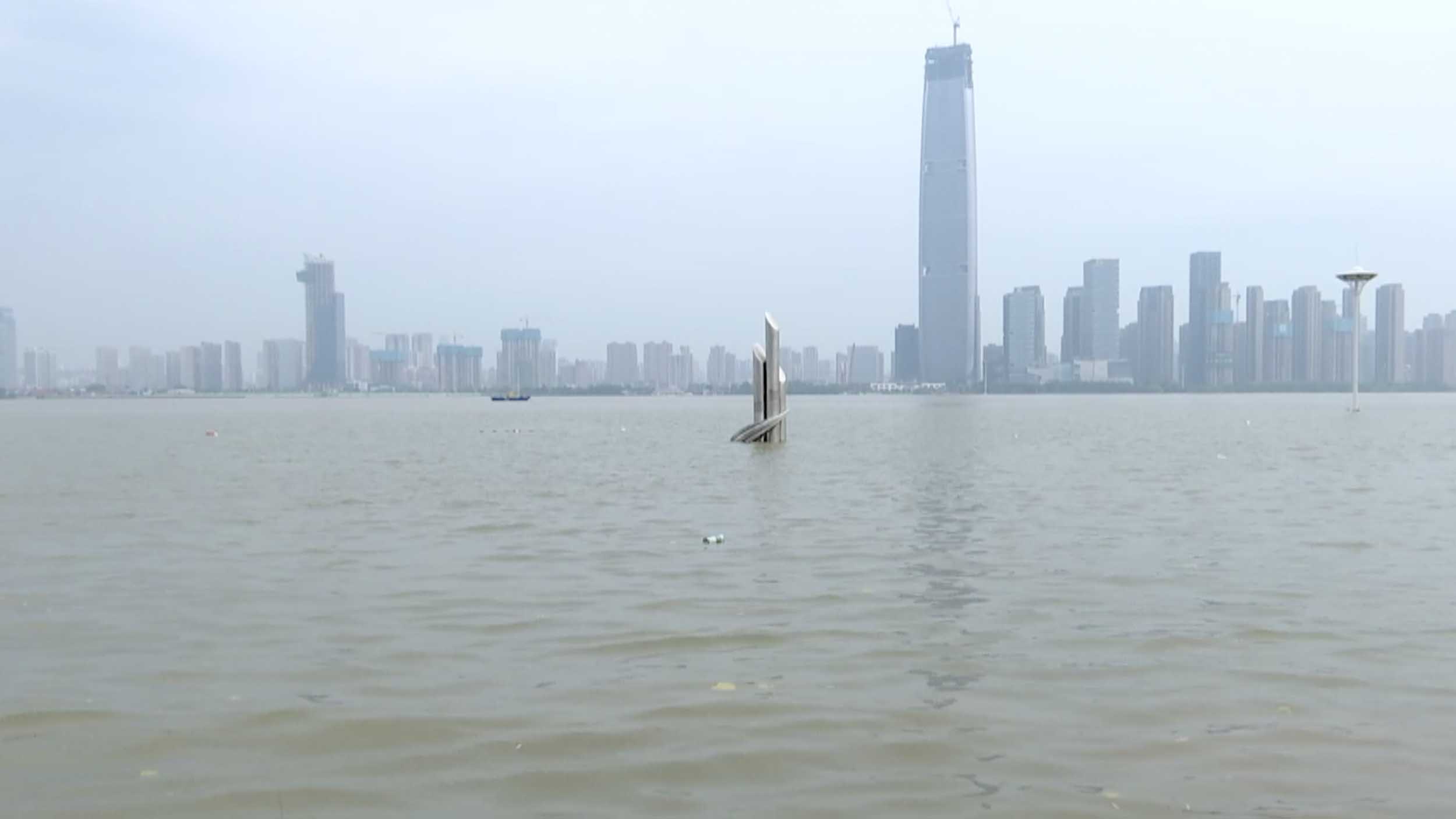
On Sunday night (July 12), water readings at the Hankou hydrological station along the Yangtze River reached 28.77 meters.
It was the fourth highest in history.
So far, 700 people have been dispatched to work on flood control.
Flood alert in Poyang Lake area downgraded to the second-highest level
The Changjiang (Yangtze) Water Resources Commission on Tuesday downgraded its alert for floods in the Poyang Lake area in east China's Jiangxi Province from the top level to the second highest.
Flooding in the Poyang Lake has passed its peak and the waters are slowly receding, said provincial authorities on Tuesday.
Latest figures showed the country's largest freshwater lake is still 3.45 meters higher its alert level, according to the authorities.
On Friday, the commission issued a red floods alert, the top level on China's four-tier scale, in the area. Days later, the lake reached a historic high of 22.6 meters on Monday – 3.6 meters past its most extreme alert level.
China Meteorological Administration issues blue alert for heavy rain in multiple provinces
China Meteorological Administration issued a blue alert for heavy rain from Tuesday to Saturday in multiple provinces in the country, including Sichuan, Guizhou, Shaanxi, Hubei, Anhui, Jiangsu and Zhejaing.
It will also marked the seventh round of heavy rainfall in the middle and lower reaches of the Yangtze River since the flood season began this year, bringing new pressure on flood control, disaster relief and and prevention of secondary disaters.
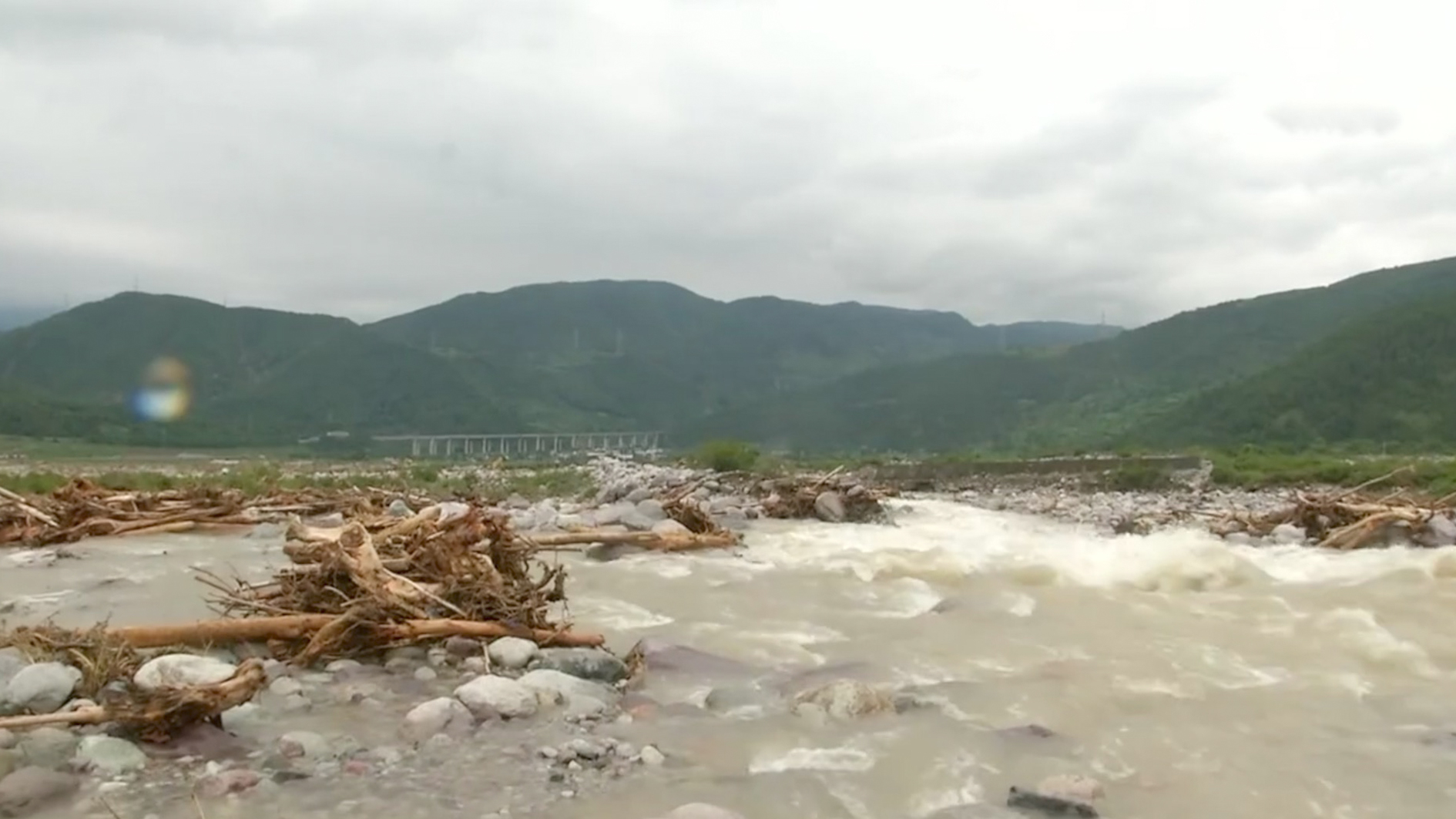
UN chief expresses solidarity with China in fighting floods
UN Secretary-General Antonio Guterres on Monday expressed solidarity with China in its fight against floods, said China's permanent mission to the United Nations (UN).
Guterres conveyed through Ambassador Zhang Jun, permanent representative of China to the UN, deep solidarity and sympathies to the affected families and to the people and government of China following the devastating consequences of floods in China, which caused the tragic loss of lives and material damage, said the Chinese mission.
Water level at Hankou hydrologic station in central China, a crucial point of the Yangtze River, dropped Monday, as the flood peak passed through the section, according to the Bureau of Hydrology of the Changjiang (Yangtze) River Water Resources Commission.
Statistics provided by the bureau showed that the Hankou station in Hubei Province registered a water level of 28.74 meters at 5:00 p.m. Monday, lower than the peak of 28.77 measured at 11:00 p.m. Sunday.
The peak level this time ranked fourth in history since 1865, after the levels in 1954, 1998, and 1999, according to the bureau.
A previous forecast showed the level would peak at around 29 meters on Tuesday, with the change taking place mainly due to storage adjustments by reservoirs in the upper reaches of the Yangtze River, according to Feng Baofei, an engineer with the bureau.

Firefighters are usually trained to deal with any kind of eventuality while on duty, but nothing could have prepared Hu Xin for what was waiting for him during a flood relief operation in east China’s Poyang County. A resident left her three-month-old baby in Hu's care while she rushed to the house to retrieve her belongings, putting the young man’s parenting skills to test. Footage from the scene showed the firefighter calmly rocking the baby, but “I was overwhelmed,” Hu admitted.
China allocates 600 mln yuan for five flood-hit provinces, cities
China on Monday allocated a total of 600 million yuan (about 85.7 million U.S. dollars) for disaster relief in five regions hit by floods, the Ministry of Emergency Management (MEM), and the Ministry of Finance said.
The funds, allocated by the Ministry of Finance and the MEM, were channeled to Jiangxi, Anhui, Hubei, Hunan provinces and Chongqing Municipality for disaster relief.
It comes on top of 615 million yuan (about 87.6 million U.S. dollars) previously allocated to six regions last Wednesday, including Jiangxi, Anhui, Hubei, and Chongqing.
Additional relief materials, including blankets and tents, have also been dispatched to Jiangxi Province, which is hard hit by the flood.
Zhou Xuewen, vice minister of the MEM, on Monday led a working team to inspect flood prevention and rescue work at Poyang Lake in Jiangxi Province.
China's State Flood Control and Drought Relief Headquarters have also sent six more teams to seven flood-hit provinces over the weekend.
Other financial aid is also being directed to flood-affected areas, such as 129 million yuan (about 18.4 million U.S. dollars) from the Ministry of Transport for road repair.
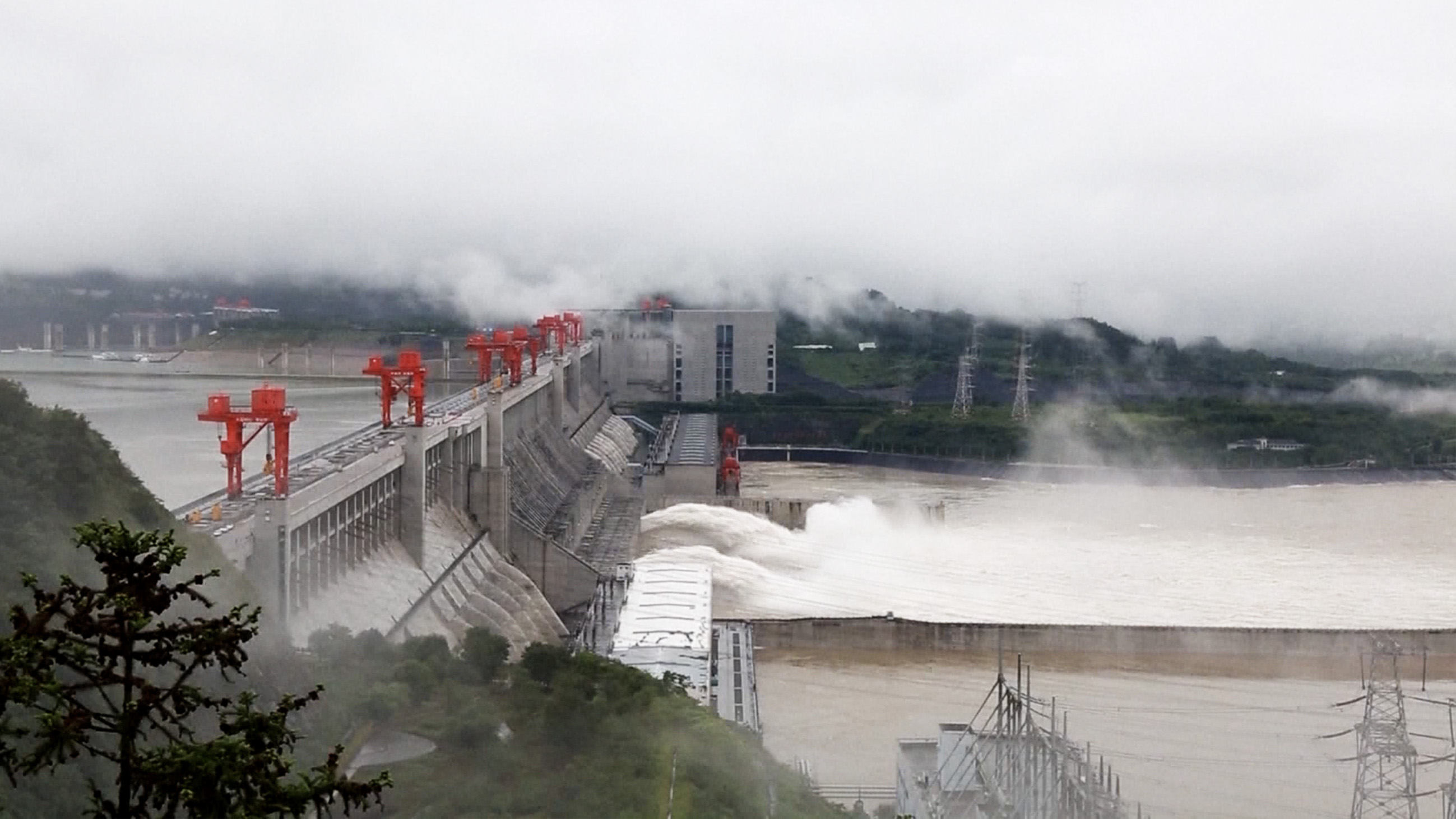
China has allocated about 309 million yuan (44.2 million U.S. dollars) for disaster relief in flood-hit regions. The funds were channeled to areas hit hard by floods, including Anhui, Jiangxi and Hubei province as well as Chongqing metropolis, in support of the reconstruction and repair of local infrastructure and public facilities.
From early warning systems to rescue missions, various forms of sophisticated technology have been used to save lives and property in China's fight against floods.
China's BDS warns of geological disasters
The recently completed BeiDou Navigation Satellite System (BDS) has played an integral role as an early warning system for geological disasters caused by floods.
Several rounds of heavy rainfall have hit Shimen County in south China's Hunan Province since the start of this year's flood season.
A massive landslide occurred there on July 6, after heavy rains caused 3 million cubic meters of a mountainside to collapse. The area was evacuated before the incident occurred, and no one was injured.
On June 24, Shimen County officials were notified of a potential geological disaster based on BDS' findings. The satellite detected anomalies in the monitoring data of hidden geological hazard points, CCTV reported.
The local authorities immediately relocated residents in nearby villages. Right before the landslide on July 6, another batch of villagers near suspected danger zones was evacuated.
Wang Dunlei, who is in charge of flood and drought prevention in Changde City, told CCTV that with high-tech means like BDS, the city can identify danger zones in advance and avoid casualty.
Fighting floods smartly
In Anqing City in east China's Anhui Province, a local telecom operator uses 5G technology and virtual reality (VR) to observe water levels in real-time.
With the low-latency 5G signal, monitoring personnel can quickly receive footage shot by 360-degree cameras and observe even subtle changes in water levels through VR goggles, thus increasing the efficiency of inspection during the flood season.
The intense rainfall has caused severe flooding and waterlogged the soil in many cities in the country.
In cities such as Fuzhou in southwest China's Fujian Province and Guiyang in southwest China's Guizhou Province, areas that easily accumulate water are marked on a map so that when it rains heavily, monitoring personnel can check the real-time status of each catchment area without the need to go out into the field.
High-tech hardware like drones and rescue robots have also made significant contributions to saving lives during the flood season.
Click here for more.

A flood-stranded pregnant woman was about to go into labor when she was rescued from her flooded house on July 12. The woman called her doctor for help after she felt irregular contractions. However, her access to the hospital was cut off by deep floodwaters.
Firefighters, along with a doctor and a nurse, took a rubber dinghy to her home. After examining her, the doctor said she needed to be transferred to the hospital. It took less than an hour for rescuers to move the pregnant woman to the hospital.
The water level of the Rongjiang River in Rongshui County reached 111.87 meters, 5.27 meters above the warning line.
A total of 433 rivers in China have exceeded alerting levels since early June, with 33 of them rising to historical highs, according to the Ministry of Water Resources on Monday.
Ye Jianchun, vice minister of water resources, released the data at a press briefing on China's efforts on flood control, adding that 109 rivers have exceeded water safety levels.
China is entering a key period in flood prevention, said Ye, warning the situation in the Yangtze River and Taihu Lake are still severe.
Earlier on Sunday, the ministry raised its flood response alert to the second highest level. The water at 10 hydrological stations along the Yangtze River have exceeded warning levels, and the water level at Taihu Lake has exceeded the warning level for 15 consecutive days, data showed on Sunday.
So far, hydrological stations at Poyang Lake, the largest freshwater lake in China, have all exceeded warning levels, and at least four of them have exceeded record water levels set in 1998.
It is expected that rivers in northern part may see greater regional floods in the future, Ye added.

The State Council Information Office holds a press conference on China's efforts in flood control in Beijing, July 13, 2020. /CGTN
So far, floods have affected 37.89 million people in 27 provinces, autonomous regions and municipalities. 141 people are dead or missing, and 28,000 houses have collapsed, according to Zheng Guoguang, vice minister of emergency management.
The ministry has dispatched 47,000 people for flood prevention, rescue and relief work. 76,000 people have been rescued or evacuated, said Zheng.
(CGTN's Yu Diqi contributes to the story.)
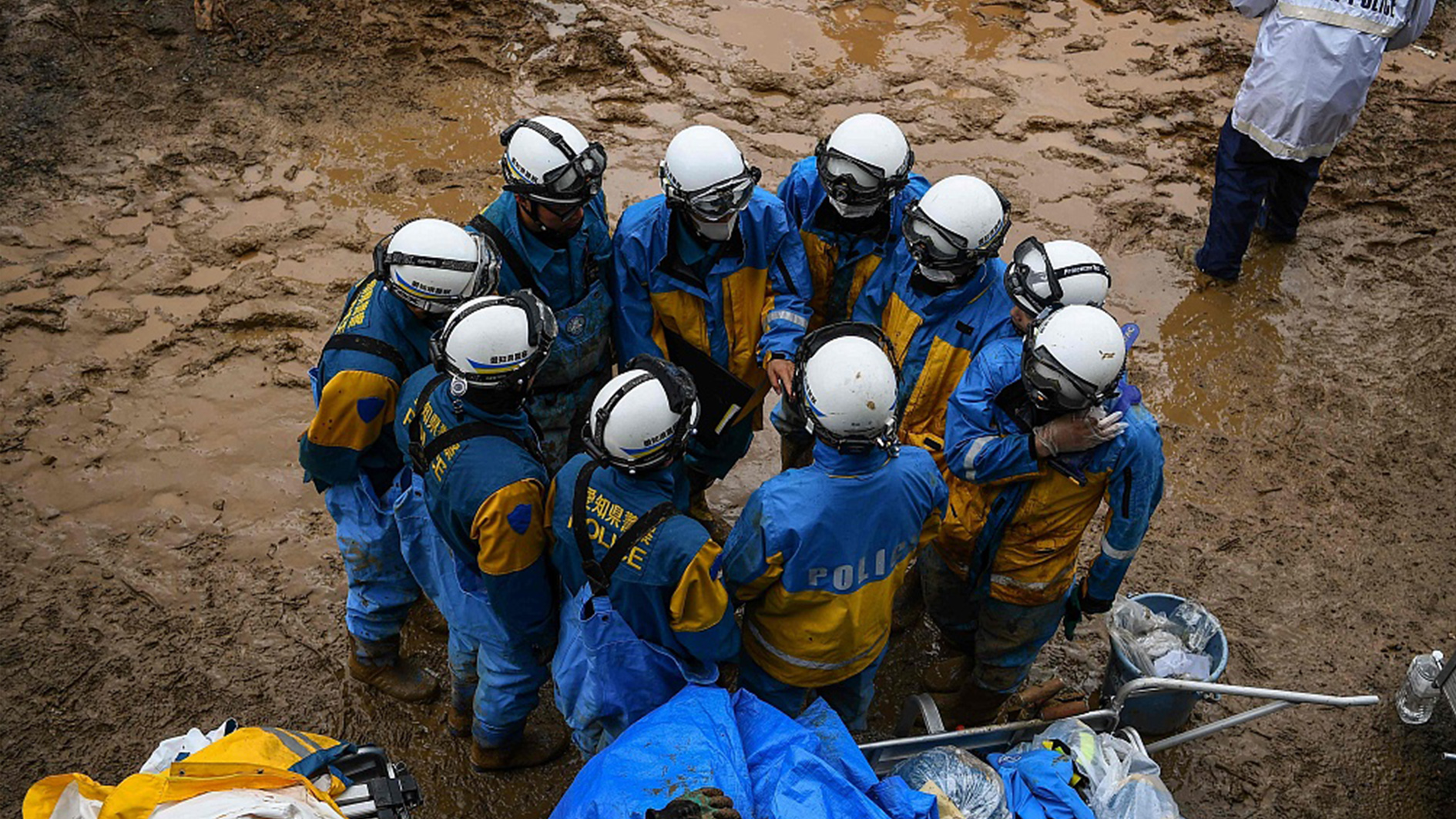
Many regions in China and Japan are being hit by violent rainstorms and flooding. China is stepping up its fight against the worsening situation, upgrading its emergency response to the second-highest level for flood and drought disaster. Over 200 rivers have burst their banks, causing severe flooding in their immediate area. The water level of Poyang Lake hasn't been as high since 1998. Schools in the eastern province of Anhui were forced to postpone college entrance exams because students couldn't reach examination centers. And, of course, it's all happening against the backdrop of COVID-19.
Xi Jinping calls for all-out efforts in flood control to ensure people's lives and safety
Chinese President Xi Jinping has called for all-out efforts in rescue and relief operations in flooded areas across the country and stressed that ensuring people's lives and safety is a top priority.
China on Sunday upgraded its emergency response to floods from Grade III to Grade II, and some 37.89 million people in 27 provinces, including Jiangxi, Anhui, Hubei, and Hunan provinces, have been affected. A total of 141 people were killed or are missing because of the floods.
Click here for more
Hubei's Honghu City upgrades flood emergency response to highest level
Honghu city, central China's Hubei Province, on Sunday upgraded its emergency response for flood control from the second to the first level, the highest on China's four-tier scale amid flood disasters, according to local authorities.
At least 14 people are dead, and five others are missing due to flooding in the province. Over 9 million people have been affected by the heavy rains.
Jiangsu raises emergency response level in some localities amid floods
The emergency response for flood control in the Taihu Lake region and the Yangtze River in east China's Jiangsu Province were upgraded to the second highest level on Sunday afternoon, according to provincial authorities.
Affected by flooding in the upper reaches of the Yangtze River and recent heavy rainfall, water levels of some major rivers and lakes in Jiangsu have been on the rise.
On Friday, Chinese authorities raised the emergency response for flood control in the Yangtze River and riverside areas to Level II, the second highest in its system.

Heavy downpours have severely hit southern, central and eastern parts of China, with the middle and lower reaches of the Yangtze River worst affected.
Weeks of heavy rains have swelled rivers and lakes, causing floods and landslides. The country has raised the emergency response for flood control in the Yangtze River and riverside areas to Level II, the second-highest. In east China's Jiangxi Province, local authorities upgraded the disaster response to the highest level as Dongting and Poyang lakes rose to "dangerous levels."
As of Friday, the economic loss from the floods has reached nearly ten billion U.S. dollars, with about 34 million people affected.
In central China's Hubei Province, the flooding has snapped power and communication lines, damaging dozens of local highways and hampering the rescue and relief work. Rescue workers on the scene are seen lifting people on their shoulders, and diving into water to unlock doors.
In southwest China's Guizhou Province, rescue workers are also doing anything they can to save lives.
"We've been here since three o'clock in the afternoon. Because of the flooding, we have to make sure that people do not get in there... and ensure their safety," Han Kexi, police officer from Guizhou Province's Daozhen County told CGTN.
In Wuyishan City of southeast China's Fujian Province, firefighters found a family of four, one of them a seven-day-old baby, trapped in a house..
In another rescue mission in the city, workers helped a five-year-old boy and his family who were stranded in the middle of a flooded street. They set up a rope bridge for them while one of them carried the young boy in his arms.
The local meteorological department has warned that torrential rain will continue to batter parts of Wuyishan City in the coming days and the water levels in local river basins will continue to rise.
Floods affect over 2.15 million people in Anhui, cause losses of 9.02 billion yuan
A total of 2.157 million people in Anhui Province have been affected by flooding, with 385,000 people urgently relocated and another 197,000 in need of emergency living assistance as of Sunday, according to the local emergency management department.
Meanwhile, a total of 208.7 thousand hectares of crops were affected, and 849 houses destroyed. The direct economic losses caused by floods have so far risen to 9.02 billion yuan (1.29 billion U.S. dollars).
The water level of the section of the Yangtze River stretching from the Huikou Station in the province has reached 22.29 meters, 2.49 meters above the warning line.
China raises flooding response level to second highest
China on Sunday upgraded its emergency response to flood control from Grade III to Grade II, the second-highest of the four-tier system since the water level in Poyang Lake in Jiangxi Province approached 22.50 meters.
Additionally, working teams have been dispatched to Jiangxi Province in the wake of the flood season, according to the Office of State Flood Control and Drought Relief Headquarters.
A total of 37.89 million people in 27 provinces, including Jiangxi, Anhui, Hubei, and Hunan, have been affected, including 141 people who were killed or missing. 2.246 million people had been evacuated, and 1,258 million people needed emergency assistance. A total of 28,000 houses were collapsed, and the affected area of crops are 35,32,000 hectares, direct economic losses amounted to 82.23 billion yuan (some 11.76 billion U.S. dollars) so far.
Water level of China's largest freshwater lake reaches peak
The water level of Poyang Lake in east China's Jiangxi Province reached 22.72 meters as of early Sunday, the highest ever recorded by the Xingzi Hydrometric Station on the lake.
The last peak level was 22.52 meters, which was recorded in 1998, when severe floods hit China.
Poyang Lake is the largest freshwater lake in China.
Over 1,500 soldiers from the Eastern Theater Command of the People's Liberation Army have arrived in Poyang County to combat rain and flooding in the area.
As of Saturday afternoon, over 5.2 million people have been affected, and 430,000 more have been relocated in regions along Poyang Lake, according to officials.
Jiangxi Province on Saturday raised its flood-control response from level II to level I, the top level of China's four-tier emergency response for floods.

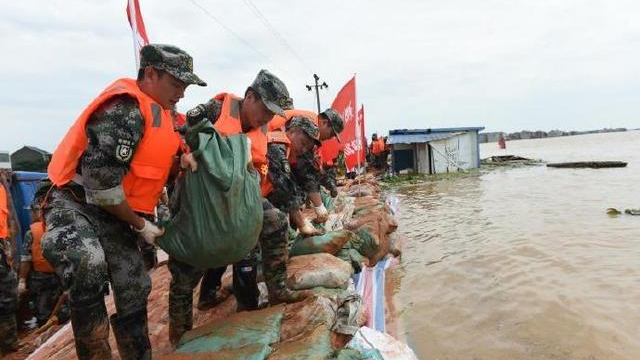
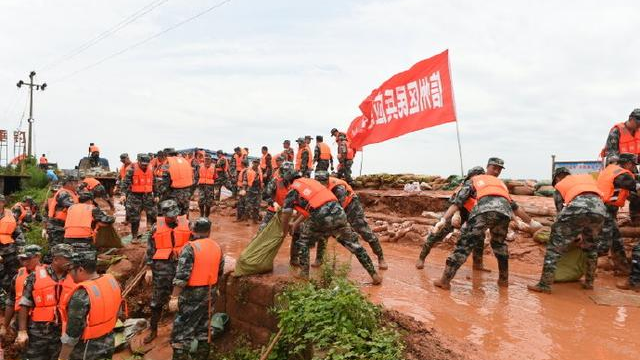
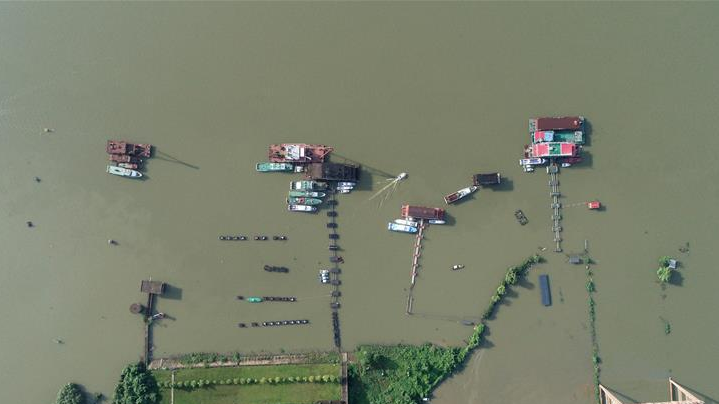

A 60-meter-long section of a highway in Rangtang County, southwest China's Sichuan Province collapsed on Saturday after the road's subgrade was eroded by rain-triggered floods. A temporary roadway was created beside the destroyed section by about 5 p.m., allowing one-way traffic. The collapsed section will remain out of use until the floodwaters abate enough for it to be repaired.
China upgrades flood and drought emergency response to Grade II
China upgraded its flood and drought emergency response from Grade III to Grade II, the second-highest of the four-tier system, as a total of 212 rivers were struck by above-warning-level floods since July 4, according to the Ministry of Water Resources.
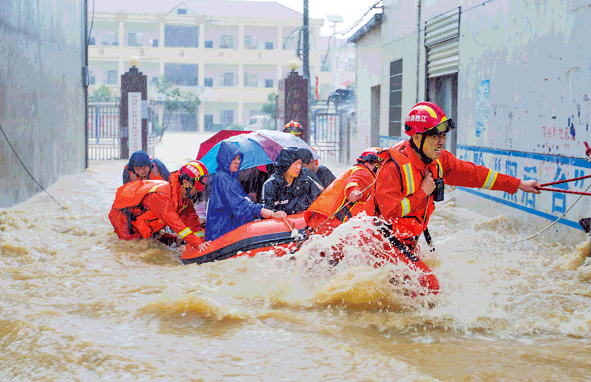
China allocates 309 million yuan for flood relief
China's National Development and Reform Commission (NDRC) allocated relief funds totaling 309 million yuan (about 44.13 million U.S. dollars) to flood-hit regions, said the commission on Saturday.
The funds were part of the central government's budget investment for disaster relief and emergency subsidies, which would be used for restoring infrastructure and public welfare facilities in disaster-hit regions, including Anhui, Jiangxi, and Hubei Provinces and Chongqing Municipality, according to the NDRC.
With downpours continuing to wreak havoc across vast swaths of China since June, several regions in China have declared highest-level flood warnings, as incessant rain triggers landslides and inundates roads and farmland.
China's national observatory on Saturday renewed its yellow alert for rainstorms, warning of heavy of weekend rain in places including Sichuan and Chongqing in the southwest, Hubei and Hunan Provinces in central China.

People swim near a flooded pavilion in Wuhan, central China's Hubei Province on July 10, 2020. /VCG
Floods affect 5,213,000 people in Jiangxi, cause losses of 6.49 billion yuan
A total of 5,213,000 people in Jiangxi Province have been affected by flooding, with 432,000 people urgently relocated and 167,000 others in need of emergency living assistance as of Saturday, according to the local emergency management department.
Meanwhile, a total of 455.7 thousand hectares of crops were affected, and a total of 75,000 hectares of crops were not harvested. 998 houses were destroyed, and the direct economic losses caused by floods have so far risen to 6.49 billion yuan (927 million U.S. dollars).
China's Jiangxi upgrades flood emergency response to highest level
East China's Jiangxi Province on Saturday upgraded its emergency response for flood control from the second to the first level, the top rung on China's four-tier scale, and one which signals disasters such as dam collapses or extraordinary floods simultaneously in several rivers.
The water level in Poyang Lake, China's largest freshwater lake which connects to the Yangtze River, was 2.3 meters (8 feet), exceeding the alert level. Severe regional flooding is forecast to hit the lake, according to the local authorities.
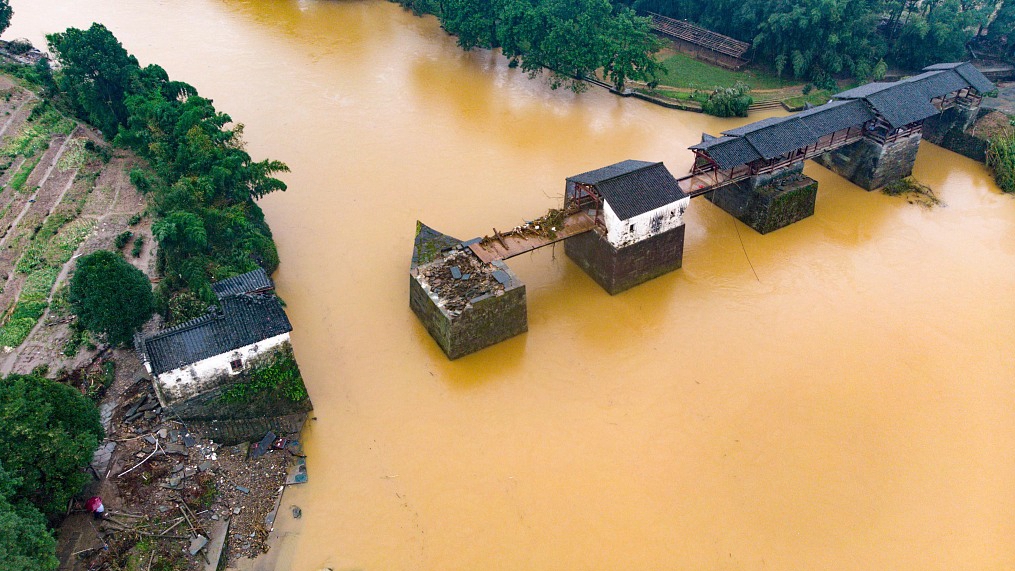
An ancient bridge is damaged by the floods in Wuyuan County, east China's Jiangxi Province, July 9, 2020. /VCG
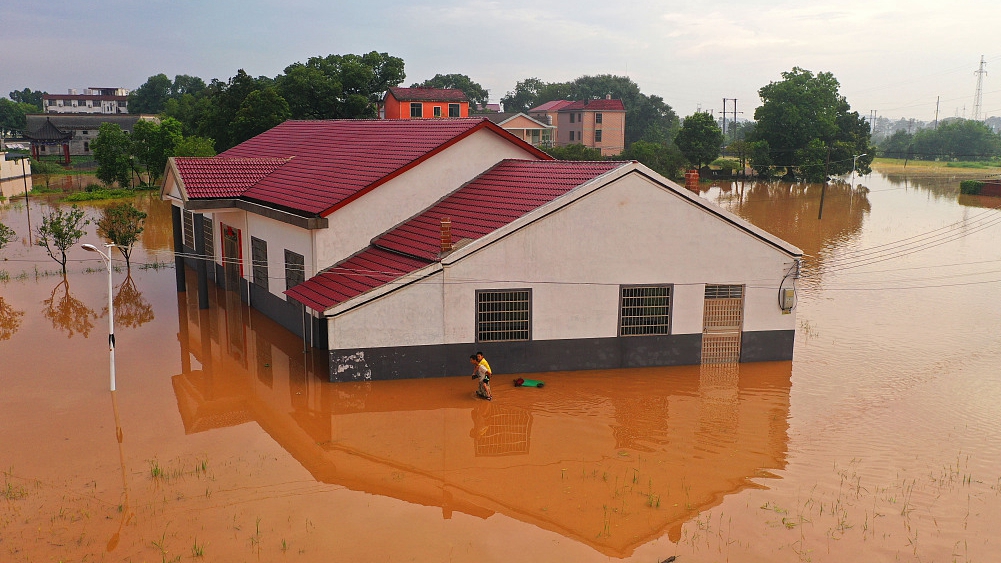
A flood batters Taihe County in Ji'an City, east China's Jiangxi Province, July 10, 2020. /VCG
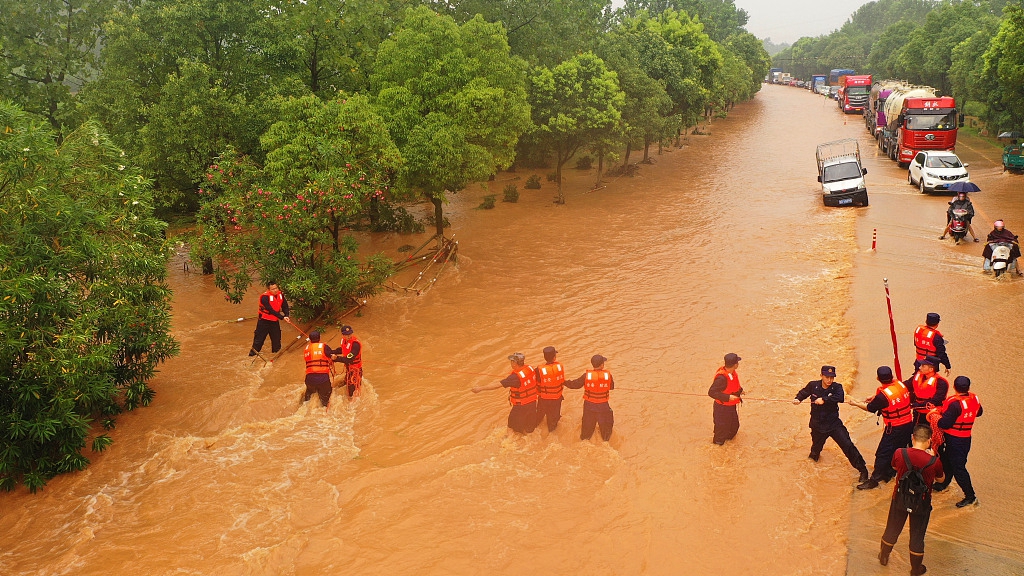
Rescuers transfer residents trapped by floodwater in Ji'an City, east China's Jiangxi Province, July 10, 2020. /VCG

East China's Jiangxi Province upgraded its emergency response for flood control from level 3 to level 2 on Friday, according to the flood control and drought relief headquarters of the province. Continuous rains have increased the water level of Yangtze River in Poyang County to three meters above the warning level, and exceeded the highest record in 1998. Heavy rainfall has caused severe waterlogging in the area, trapping many residents. In a video, a firefighter carried an old man on his shoulder as floods hit the county.
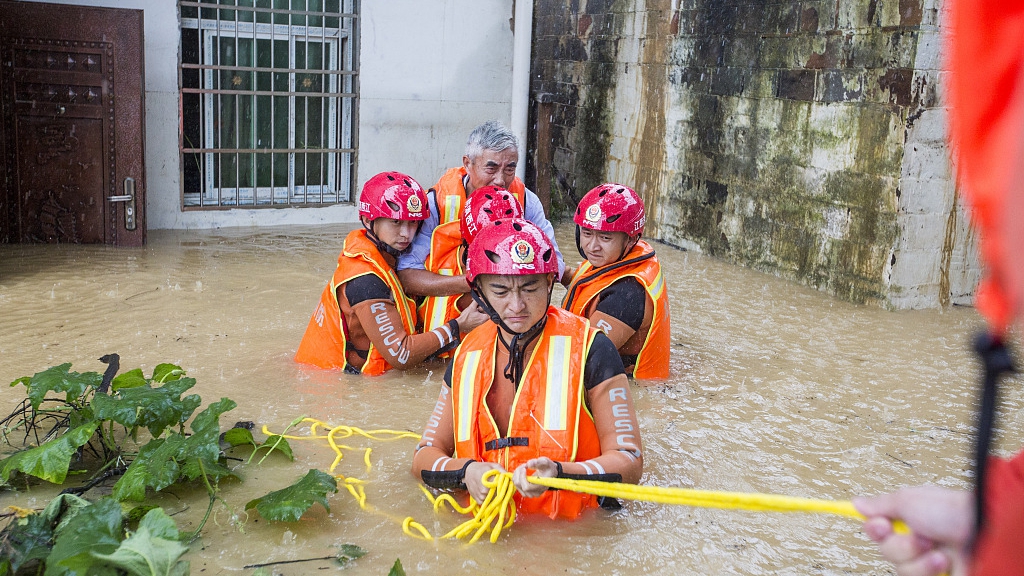
Rescuers transfer residents trapped by floods in Jiujiang City, east China's Jiangxi Province, July 8, 2020. /VCG
A total of 140 people have died or are missing and 30.20 million have been affected due to floods in 27 provincial-level regions, including east China's Anhui and Jiangxi provinces as of 2:00 p.m. local time Thursday, the Ministry of Emergency Management said.
As of Thursday, 1.721 million people were relocated, and 22, 000 houses collapsed.
The floods have caused direct economic losses worth 61.79 billion yuan (some 8.81 billion U.S. dollars).
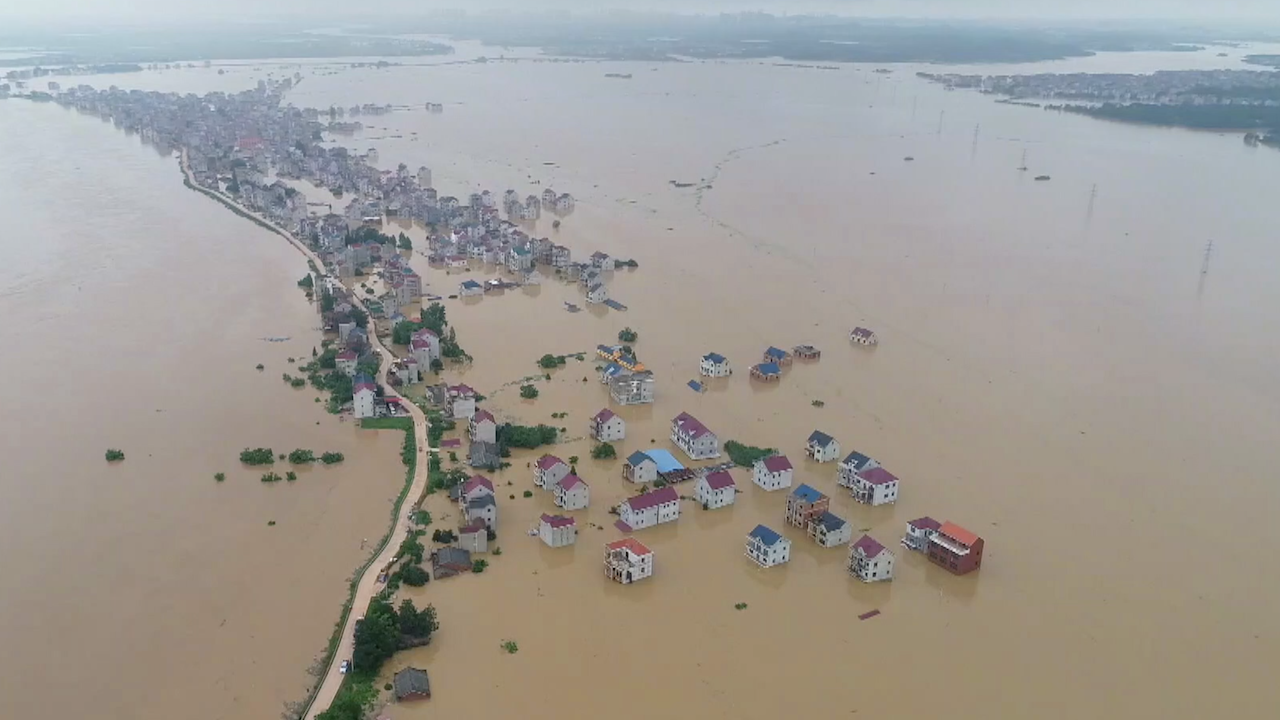
Poyang County in east China's Jiangxi Province was hit by floods after heavy rains, leading to the evacuation of more than 9,000 people, but no casualties. The Changjiang River has seen its biggest floods in the past two decades, with waters breaching the embankment at Dengjia village. Over 10 square kilometers of farmland have been flooded. Some 600 personnel joined the rescue and relief work.

Rescue workers saved a seven-day-old baby and his mother after they were caught in a flood in Wuyishan City in southeast China's Fujian Province on Thursday. The baby boy's constant crying alerted rescue workers as they passed by a wood processing factory. A downpour hit the city of Wuyishan in the morning of July 9, causing flooding and trapping residents inside their homes. The fire department in nearby Fuzhou City sent 160 firefighters, 12 boats and 23 trucks to assist in the rescue effort. As of Thursday afternoon, a total of 171 trapped residents had been saved and 523 residents had been evacuated to safe places.
Yellow alert for rainstorms renewed as heavy rains continue in S China
China's national observatory on Friday renewed a yellow alert for rainstorms across vast regions of the country for the next 24 hours.
From Friday morning to Saturday morning, heavy rain and rainstorms are expected in 13 regions including provinces of Jiangxi, Anhui, Hubei, Hunan, Sichuan and Anhui.
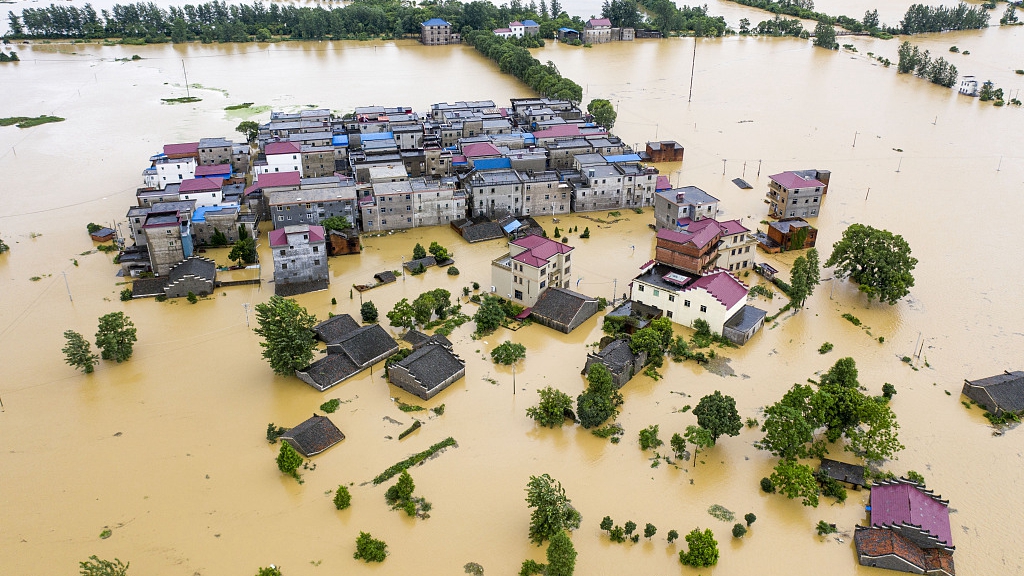
Heavy rain causes flood in a village in Jiujiang City, east China's Jiangxi Province, July 8, 2020. /VCG
Premier Li calls for all-out efforts in flood control
Chinese Premier Li Keqiang has called for all-out efforts in the rescue and relief work regarding flood disaster, and ensuring people's lives and safety as top priority.
Premier Li made the remarks in a meeting held on Wednesday on the country's flood control and disaster relief.
Officials at the meeting said people's lives are the priority in the combat against floods, urging local governments and departments to clearly identify responsibilities and combine prevention work with the emergency response.
Efforts should be made to strengthen monitoring over the flood situation to identify potential risks in a timely manner and to well organize rescue and relief work, officials underlined.
Click here for more.
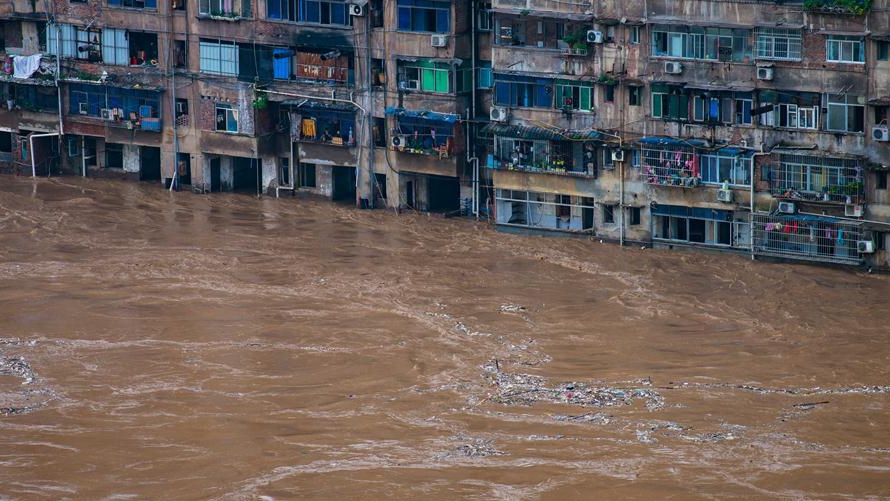

On July 8, for the first time since 1961, when it was built, the Xin'anjiang Reservoir opened all nine floodgates to discharge water into Qiandao Lake in Zhejiang Province. Water flow rates are estimated to rise to 8,000 cubic meters per second. Authorities claimed the main reason for the discharge was heavy rains and floods which caused Qiandao Lake to rise rapidly and exceed the flood limit.
8 confirmed dead in central China landslide
Eight of the nine people buried in a landslide in Huangmei County, central China's Hubei Province, have been confirmed dead.
The landslide was caused by heavy rainfall in the area.
According to the local flood control and drought relief headquarters, the landslide occurred at around 4 a.m. Wednesday in Dahe Township in Huangmei County.
One person was injured and more than 40 villagers have been relocated.

The Xin'an River Reservoir, an important flood control project in the upper reaches of the Qiantang River, opened all nine of its spillways to discharge floodater, in Zhejiang Province, east China, July 8, 2020. /VCG
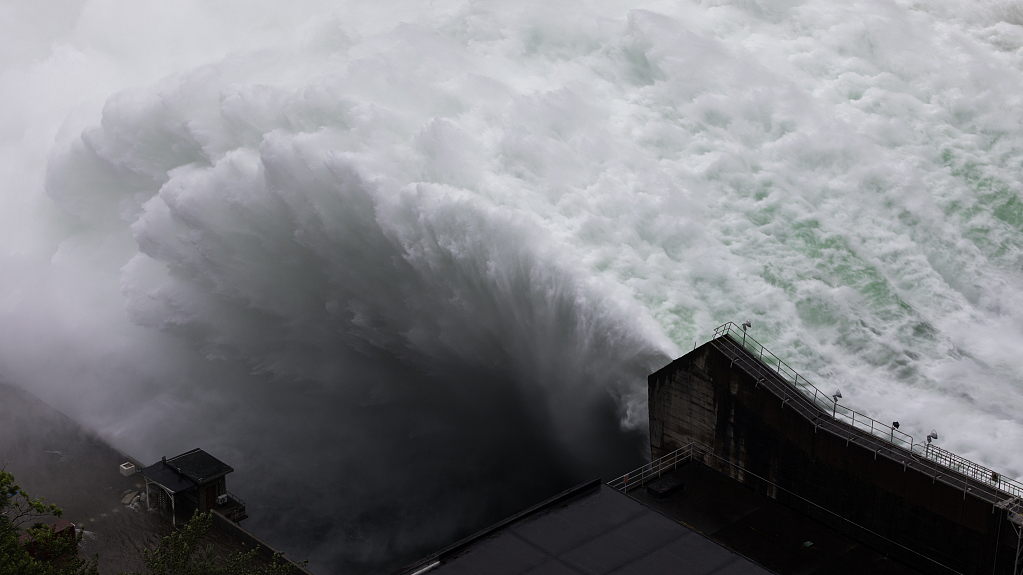
This is the second time all of the reseervoir's spillways have been opened since the completion of the reservoir's construction in 1959. The reservoir had all ifs spillways test run for the first time in 1966. /VCG
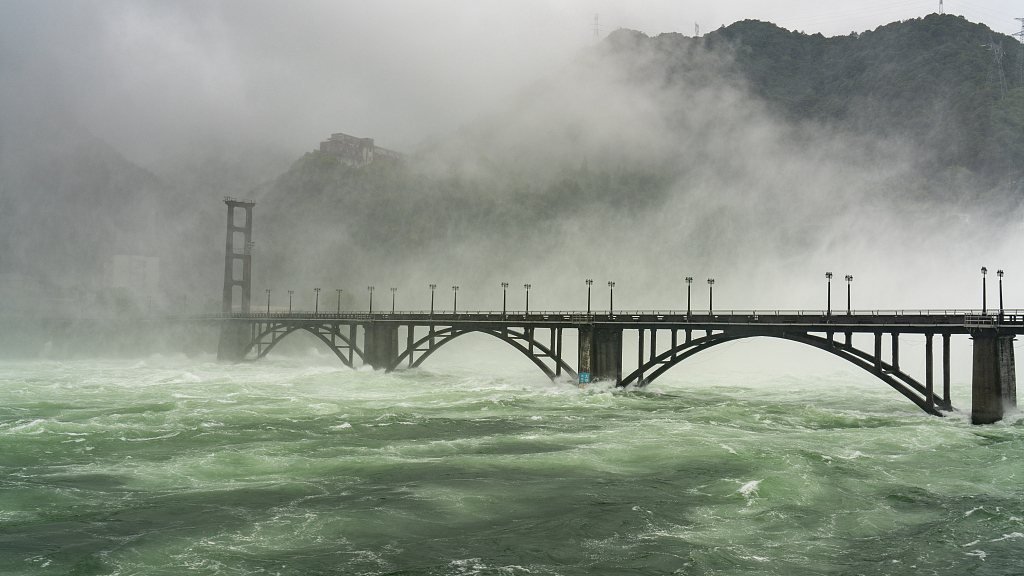
The Xin'an River Reservoir is more commonly known as Qiandao Lake. /VCG
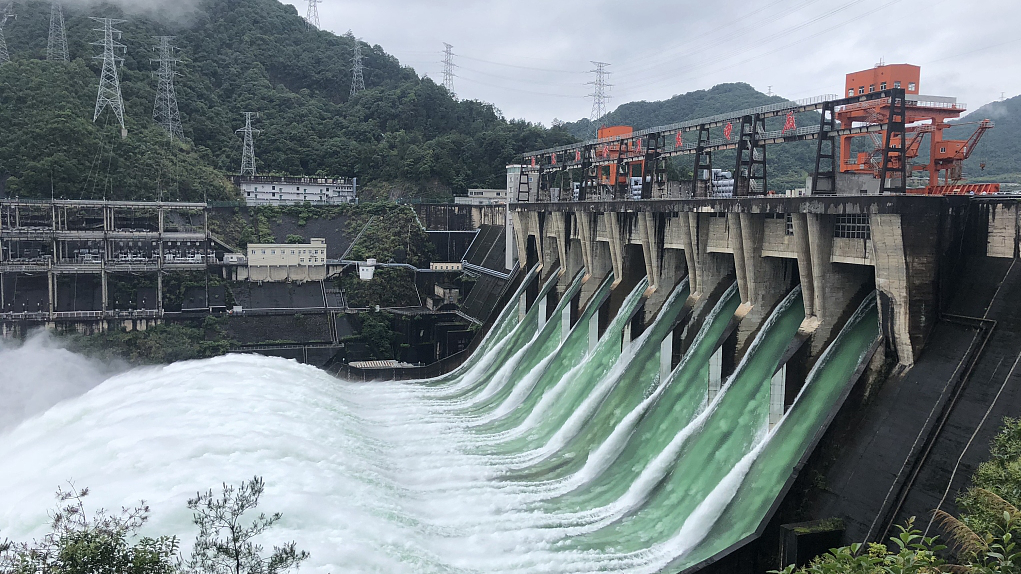
It is the main source of drinking water for Zhejiang Province and serves as a strategic reservoir for the Yangtze River Delta. /VCG
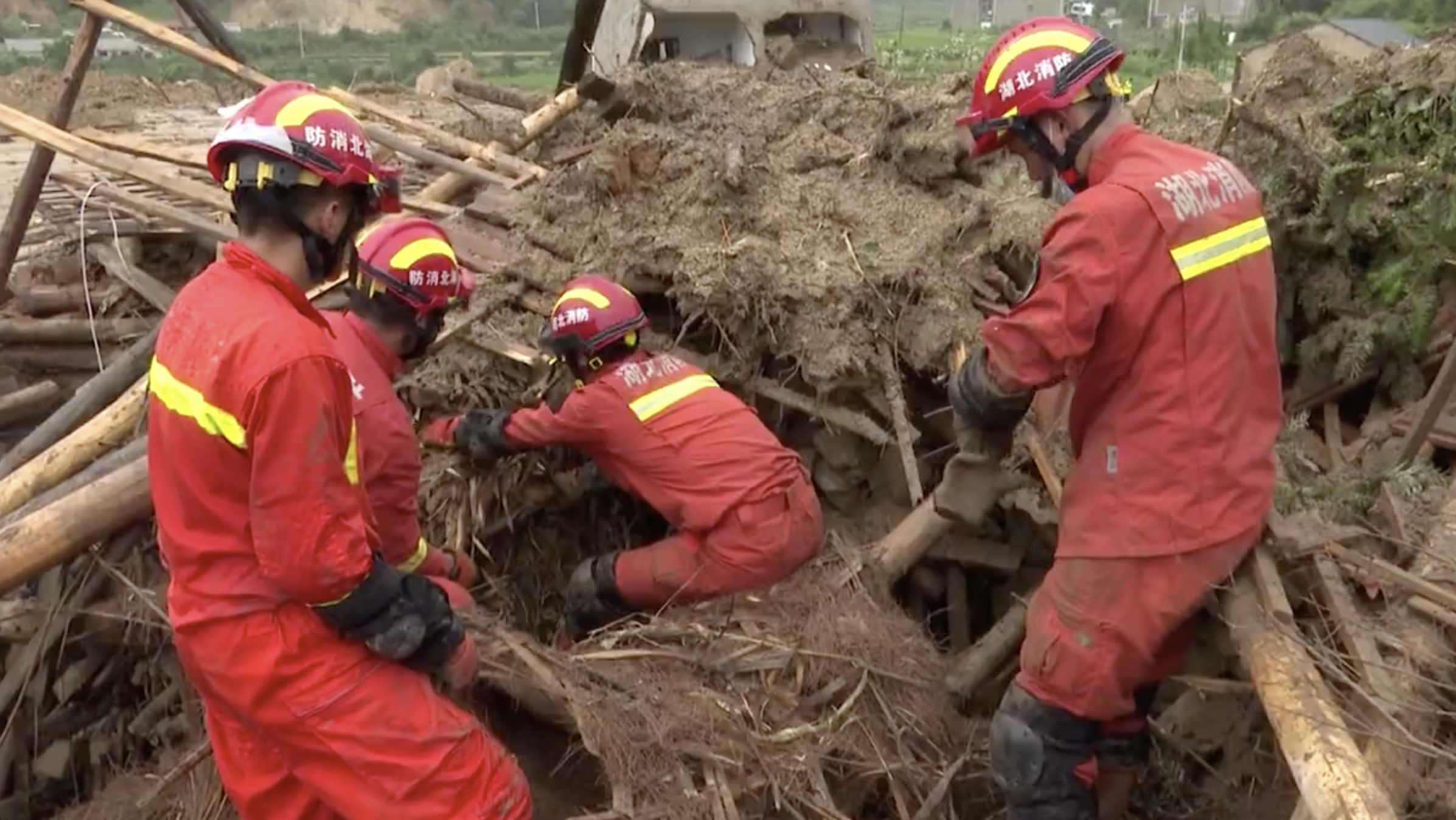
Due to torrential rains, nine villagers were buried in a sudden landslide on July 8 in Hubei Province, central China. First responders were deployed for the rescue mission. As of 3 a.m. on July 9, eight buried people were rescued, but seven had no vital signs. The rescue work is still ongoing.

Due to flooding in multiple cities in China, police in Anqing City, east China, used a bathtub as a "boat" to transport students who're taking the national college entrance exam.

Students enter their exam sites, Wednesday, for the national college entrance examination, or Gaokao, in Shexian County, east China's Anhui Province. /CFP
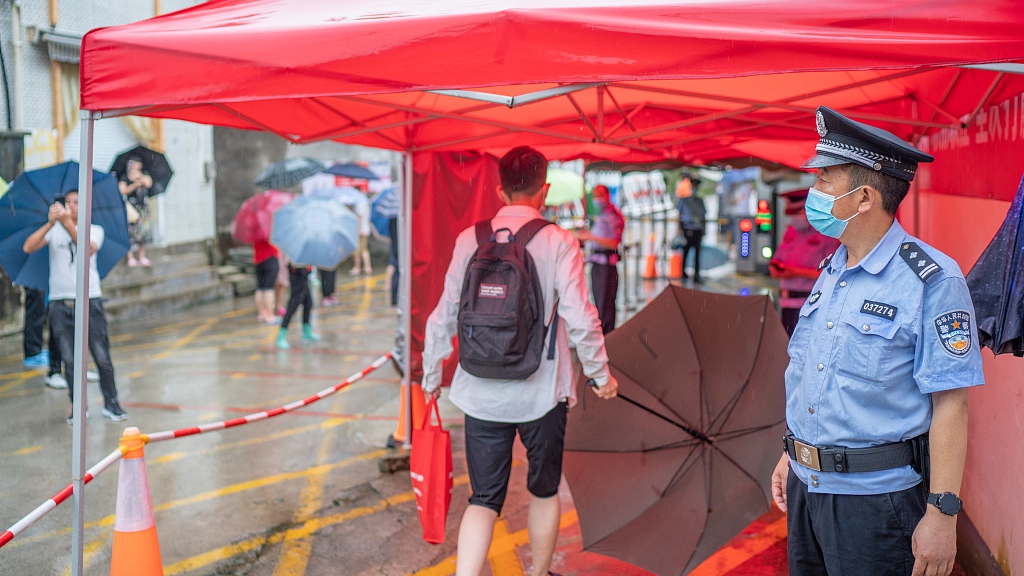
Chinese language and math exams scheduled for Tuesday were postponed to Thursday, as heavy rains and floods made many of the county's students unable to reach their exam venues on time. /CFP

They were able to take Wednesday's exams as scheduled, as the floods gradually waned. /CFP
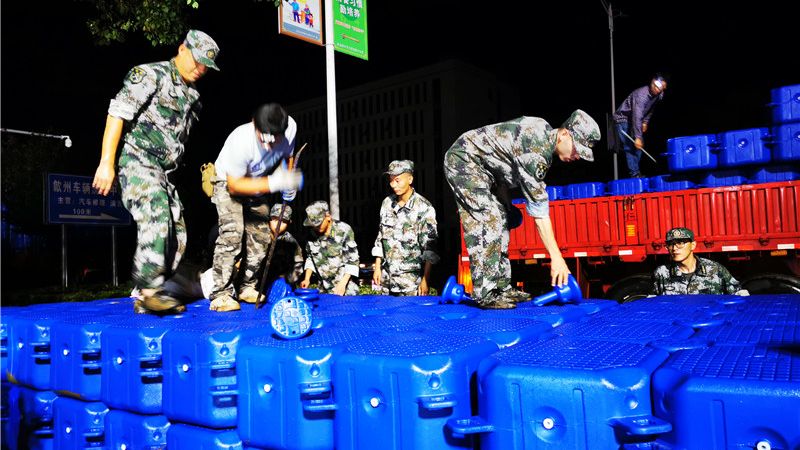
Pontoon bridges are built overnight to ensure students to get to the exam venues safely on time. /CNR
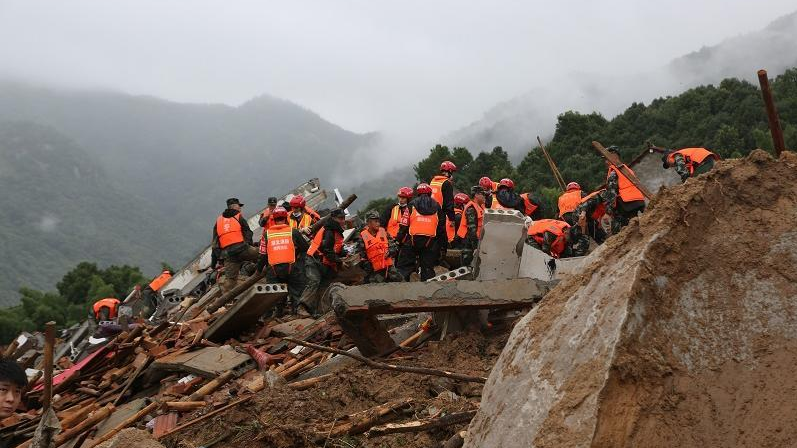
Rescue work is underway as a landslide hit Huangmei County in central China's Hubei Province, July 8, 2020. /CCTV
Seven people are confirmed dead and one person is injured in a landslide caused by heavy rainfall in Huangmei County in central China's Hubei Province, on Thursday, according to local media reports.
The search operation for a remaining missing person is still underway, the reports said.
According to the local flood control and drought relief headquarters, the landslide occurred at around 4 a.m. Wednesday in Dahe Township in Huangmei County.
More than 40 villagers have been relocated and the rescue work is underway.
On the same day, a landslide also hit Songtao County in southwest China's Guizhou Province. Six people remain missing.
The disaster has affected 79 households so far. Casualties and property losses are being counted, and search and rescue operations are underway.
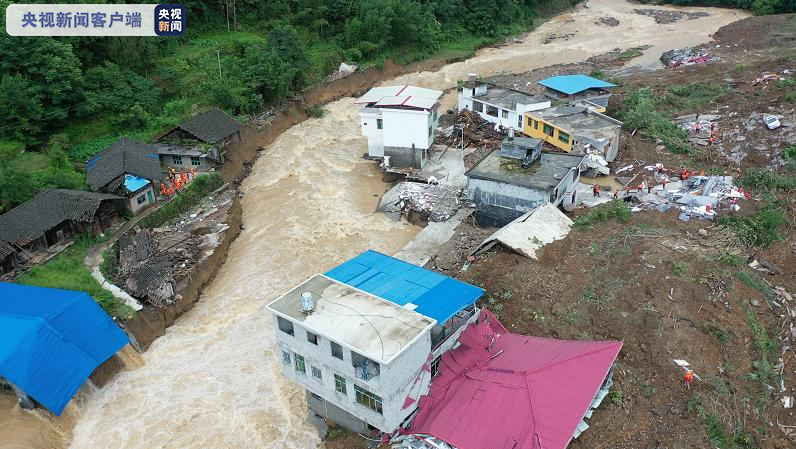
Rescue work is underway as a landslide hit Songtao County in southwest China's Guizhou Province, July 8, 2020. /CCTV
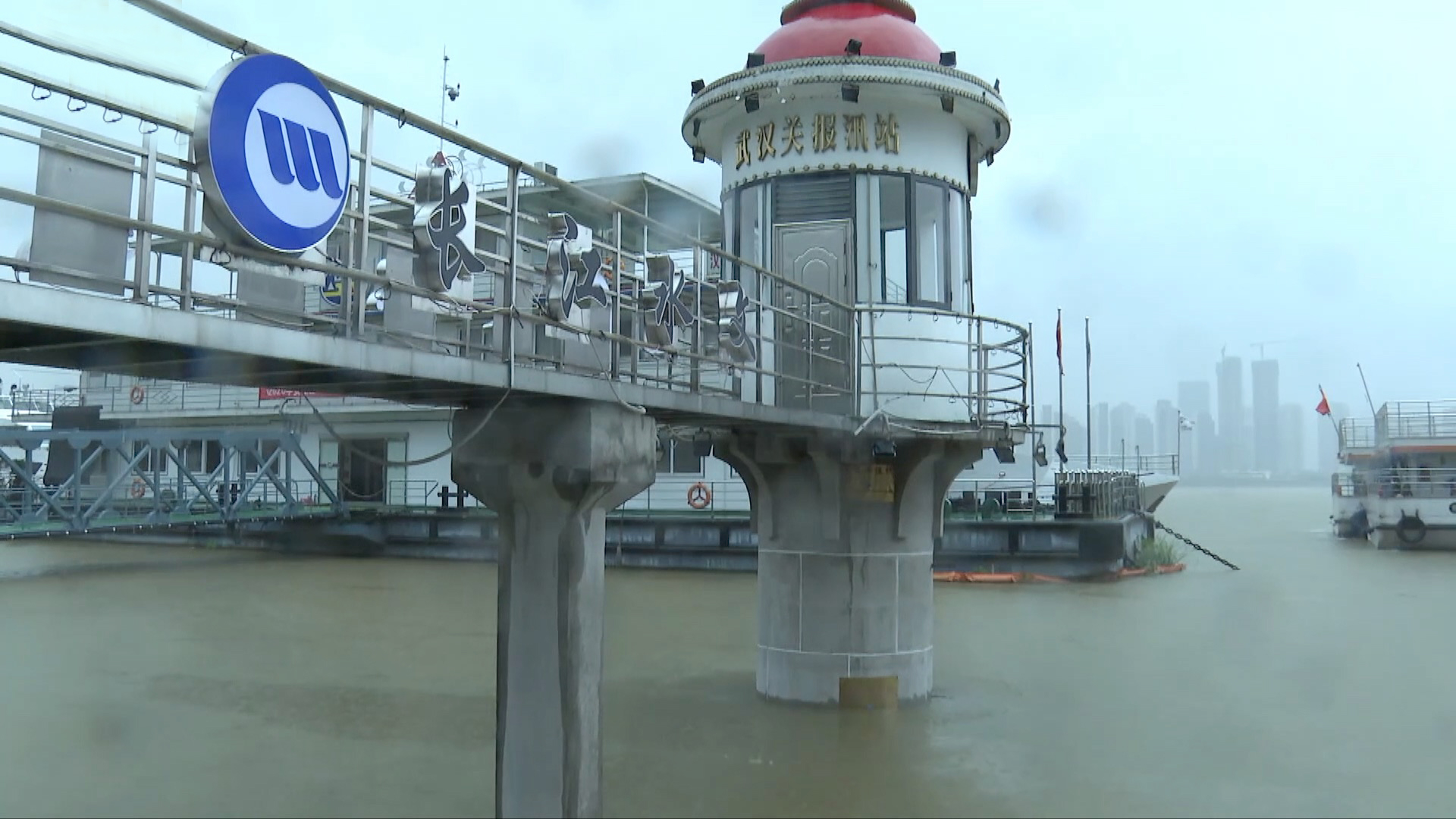
Relentless rain in southern China has led to extreme water levels in many parts of the Yangtze River. On Tuesday morning, the reading at the Hankou Hydrological Station in Wuhan exceeded the warning level of more than 27 meters. The city's ferry services have been suspended. Several other stations along the river have also reported dangerous levels. More rain is forecast in these regions in the coming days. Chinese authorities have upgraded their emergency flood response.
China on Tuesday upgraded its emergency response to flood control from Grade Ⅳ to Grade III, the third-highest of the four-tier system.
Additionally, nine working teams have been dispatched to several provinces including central China's Hunan and Hubei in the wake of the flood season, according to the Office of State Flood Control and Drought Relief Headquarters.
So far, a total of 13,177 professional rescuers have been dispatched across the country.
At least 3,200 rescue operations have been carried out during the flood season nationwide and rescued over 6,400 people so far.
On June 11, an official from China's Ministry of Water Resources said a total of 148 rivers were struck by above-warning-level floods as China entered the main flood season.
As heavy rainfalls continue and water levels in local rivers and lakes keep rising, several Chinese regions have raised their flooding response levels in the past few days.
The Anhui provincial meteorological service on Sunday raised the rainstorm response to the second level from the third level.
Due to severe flooding, Shexian County in Huangshan City even rescheduled Tuesday's national college entrance examination, or Gaokao, as most students were unable to reach their exam venues on time.
Wuhan, capital of central China's Hubei Province, also upgraded its emergency response for flood control from Grade III to Grade II on Monday.
Heavy rain has affected over 420,000 people in east China's Anhui Province, as local authorities launched the level II emergency response, the second-highest, for flood prevention Tuesday.
The downpour that started on July 2 has affected seven cities and 31 county-level administrations in the province, leading to the evacuation of 27,000 people and a direct economic loss of 510 million yuan (72 million U.S. dollars) as of Monday, local emergency management department said.
The rain has also affected 31,700 hectares of crops and damaged 617 houses.
The province raised its emergency response for flood prevention from level III to level II starting 12:00 p.m. Tuesday as the waters of multiple rivers exceeded warning levels, according to the provincial flood control and drought relief headquarters.
Under the threat of continuous heavy rain, the national college entrance examination did not proceed as scheduled in Shexian County, Anhui.
All of the 2,000-plus examinees in the county were affected on Tuesday morning as most of them were unable to reach exam venues on time.
And exams on Chinese language and math originally scheduled on Tuesday have been rescheduled to Thursday (July 9) while tests on other subjects will be held as scheduled on Wednesday.
At least four people are missing in Xiaojin County in southwest China's Sichuan Province as heavy rainfalls caused landslides, according to local authorities.
The landslide occurred on Sunday morning and the county immediately activated a level II emergency response following the incident.
A search and rescue operation is underway.
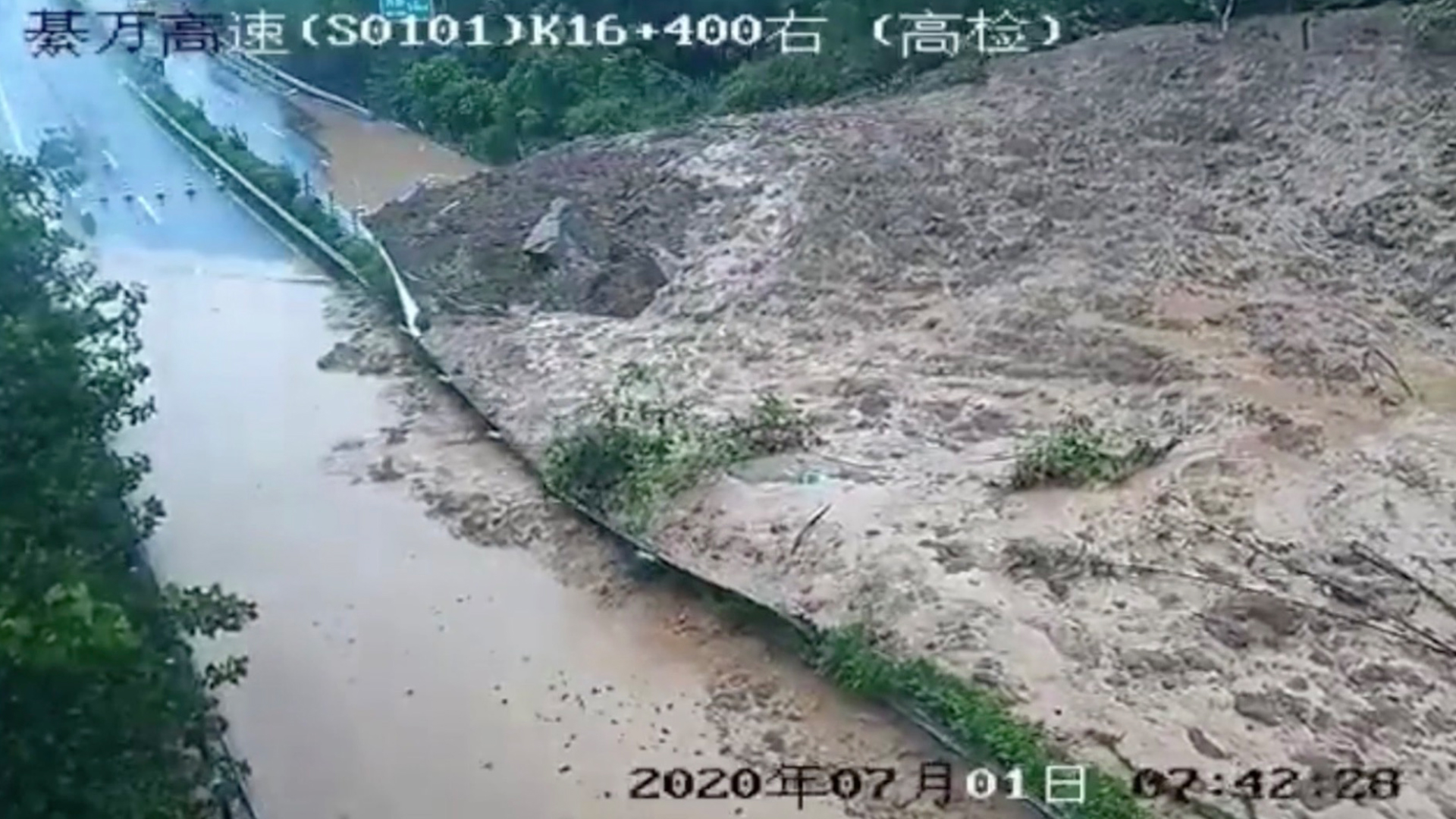
Heavy torrential rain caused a spillway tunnel to collapse and spurred a mudslide that washed away guardrails along a stretch of road on the Third Ring Expressway in southwest China on July 1.
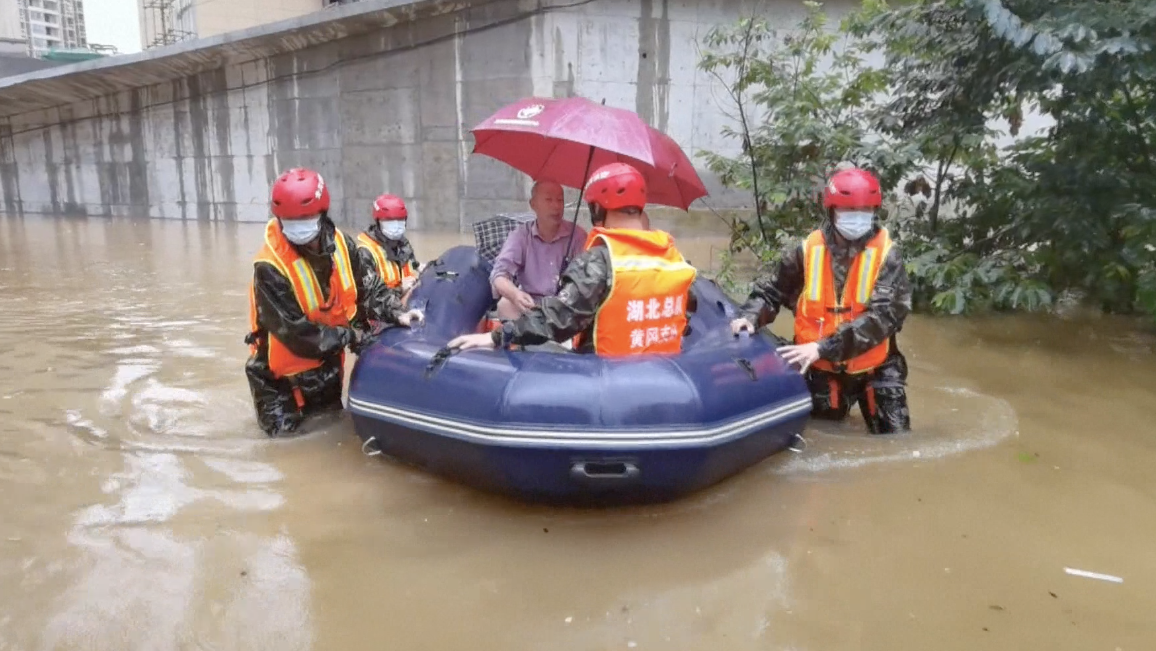
Heavy rains continue to batter China's central, southwestern, eastern and northern provinces, prompting urgent flood control, disaster relief and rescue work. The rain-triggered floods trapped some locals on the road in Tianmen City. Local departments of public security acted rapidly to help with the evacuation. Waterlogging also raised concerns in Qianjiang City.
There were six spots in the city that experienced over 30-centimeters of accumulated water. Firefighters quickly responded with disaster relief operations. The firefighters successfully helped more than ten trapped people get to safety after two hours. Local authorities sent personnel to the affected section immediately and started emergency dredging work, with both excavators and transportation vehicles dispatched.
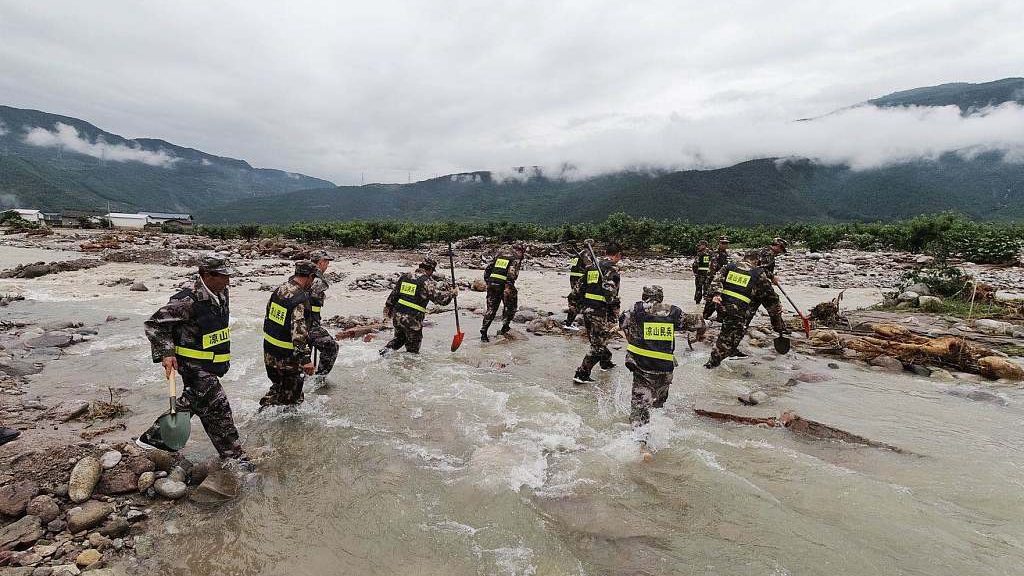
At least 19 people were killed and three are still missing after a heavy rainstorm lashed the county of Mianning in southwest China's Sichuan Province, the information office of the Mianning County government said in a notice published on Friday evening.
Nearly 500 people, including local civil rescuers and over 100 vehicles, have participated in search and rescue operations on Friday.
Torrential rains hit the county on June 26, and 5,660 people are in temporary settlements in the county as of Tuesday, the office earlier said.
Meanwhile, the direct economic loss caused by the rainstorm amounted to 738 million yuan (about 104 million U.S. dollars), the office noted.
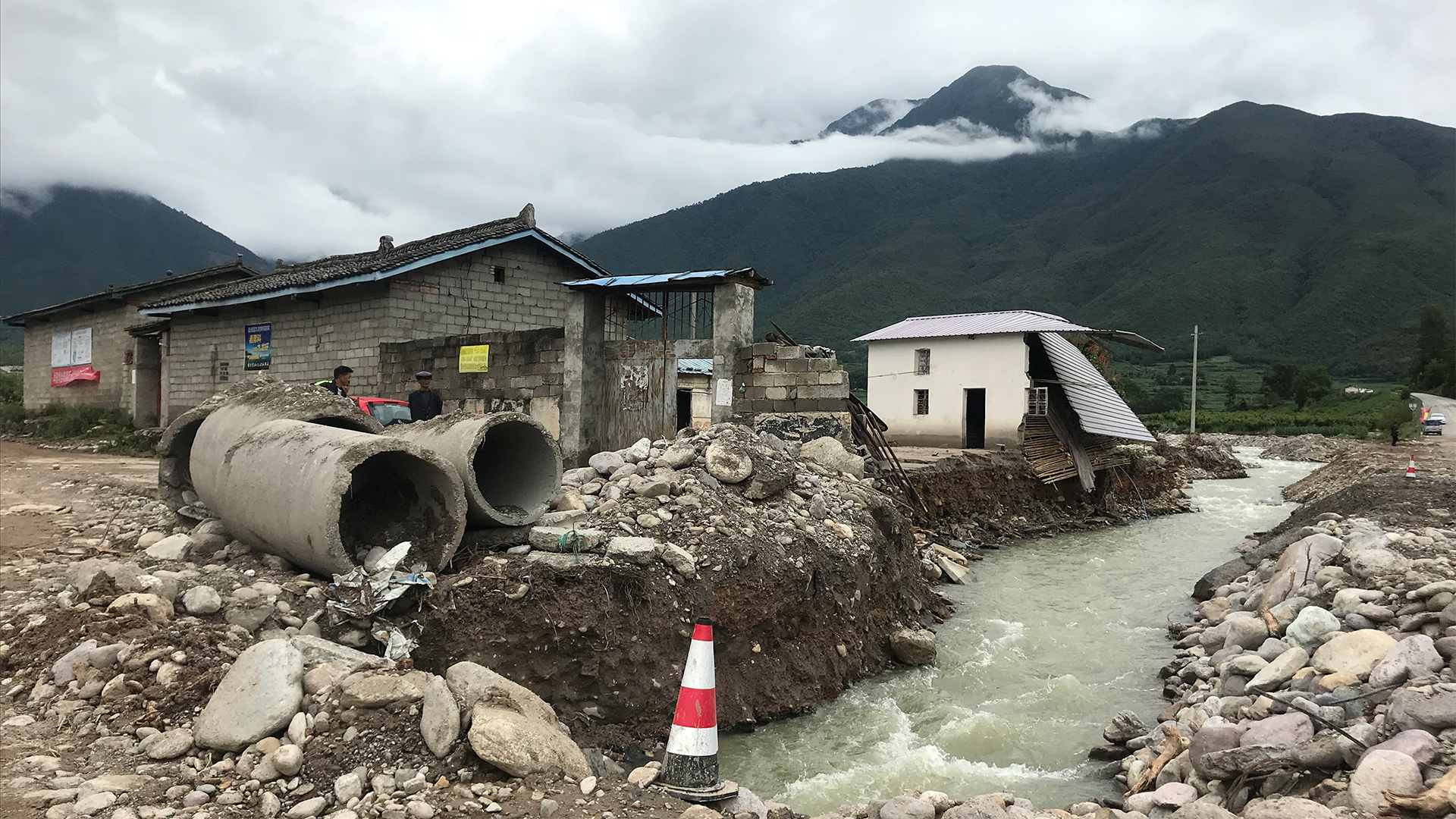
Carrying out flood disaster rescue work while preventing COVID-19 infections is one of the biggest challenges for local authorities in Mianning County.
Since June 27, local health authorities are continuously conducting disinfection in the county's COVID-19 isolation areas and monitoring water quality.
According to Yihai Town's Party secretary Lu Zhen, the pressure is mounting due to the high and a concentrated number of people living at temporary shelters.
Read more:
Floods and COVID-19 put Sichuan to the test
China Rainstorm: Authorities continue rescue operations amid COVID-19 concerns
(Cover: CMG)
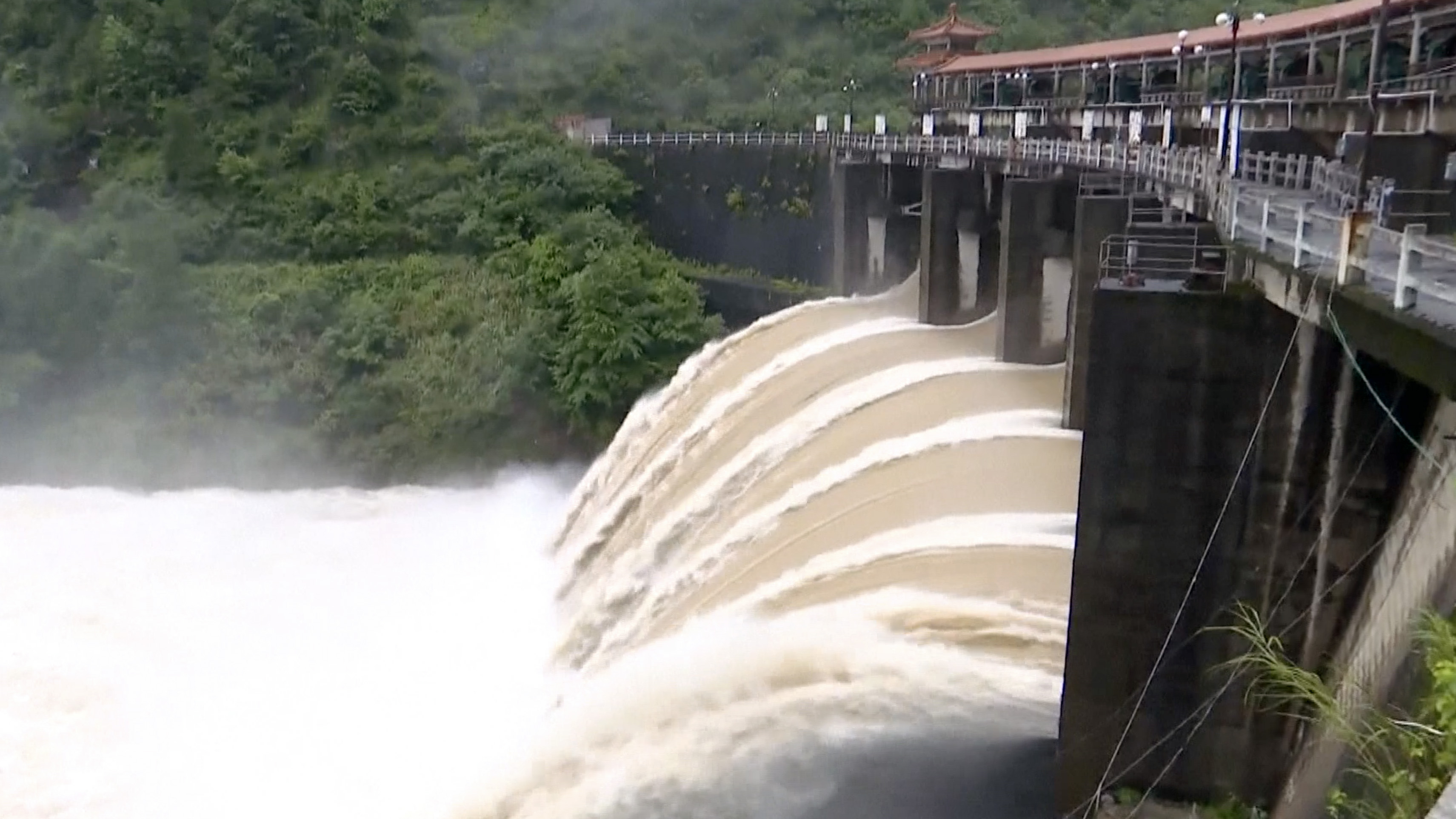
Heavy downpours continued to batter large swathes across China, causing flooding, mudslides, and numerous evacuations. Cities of southwest and east China are facing different degrees of effect of rainstorms.
China on Sunday activated a level-IV emergency response, the lowest in the country's four-tier warning system, after rainstorms triggered floods in central and southwestern regions of China, the Ministry of Emergency Management (MEM) said.
The China National Commission for Disaster Reduction and the MEM have sent special work teams to major disaster areas in the provinces of Sichuan, Guizhou and Hunan to provide guidance in disaster relief.
Since the beginning of June, the floods have affected about 12 million people, leaving 78 people dead or missing. Over 8,000 houses collapsed while 97,000 houses were damaged in 13 provincial-level regions.
Direct economic losses amounted to 25.7 billion yuan (about 3.64 billion U.S. dollars), according to the ministry.
Read more:

Copyright © 2020 CGTN. Beijing ICP prepared NO.16065310-3
Copyright © 2020 CGTN. Beijing ICP prepared NO.16065310-3
Copyright © 2020 CGTN. Beijing ICP prepared NO.16065310-3